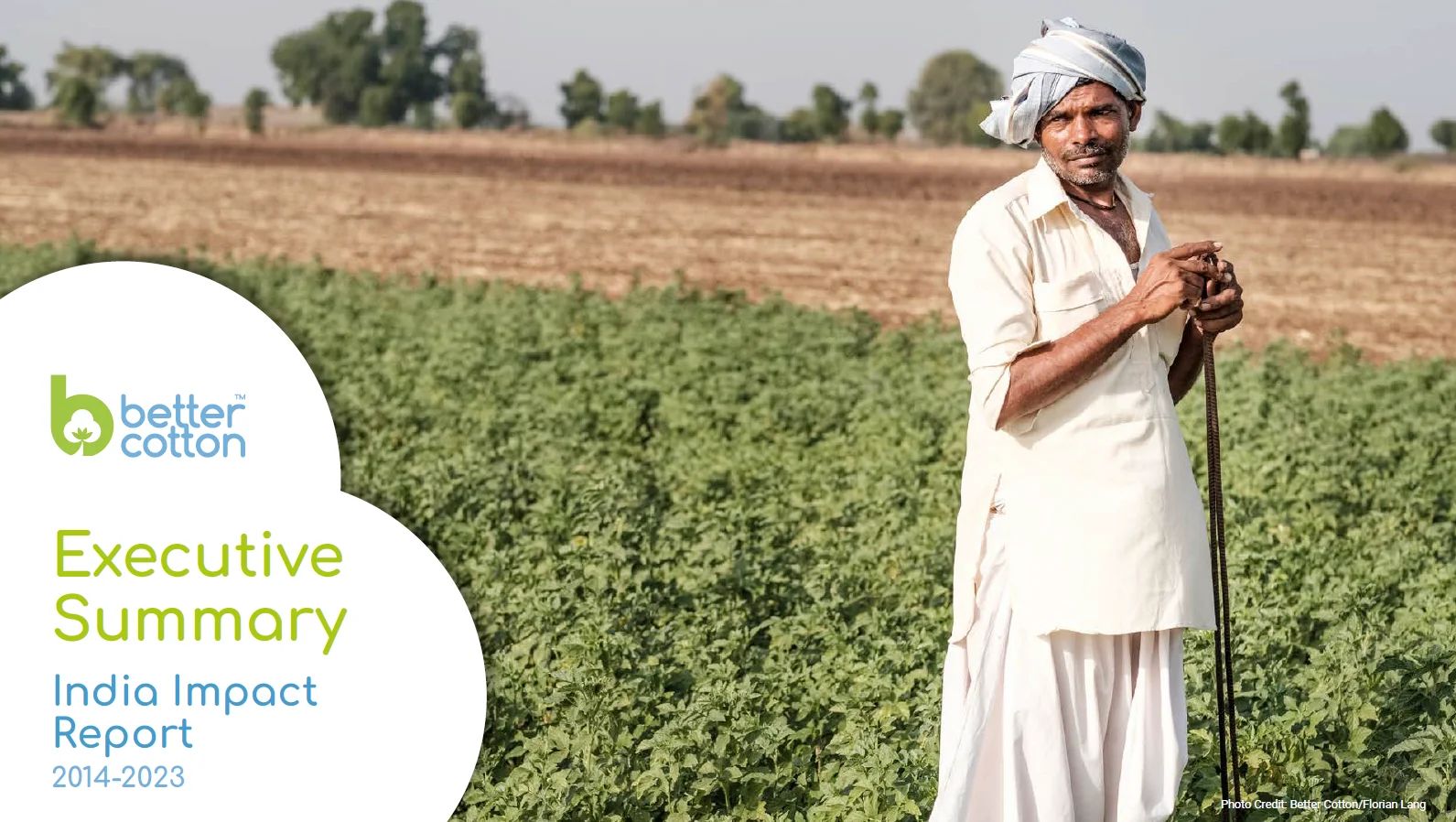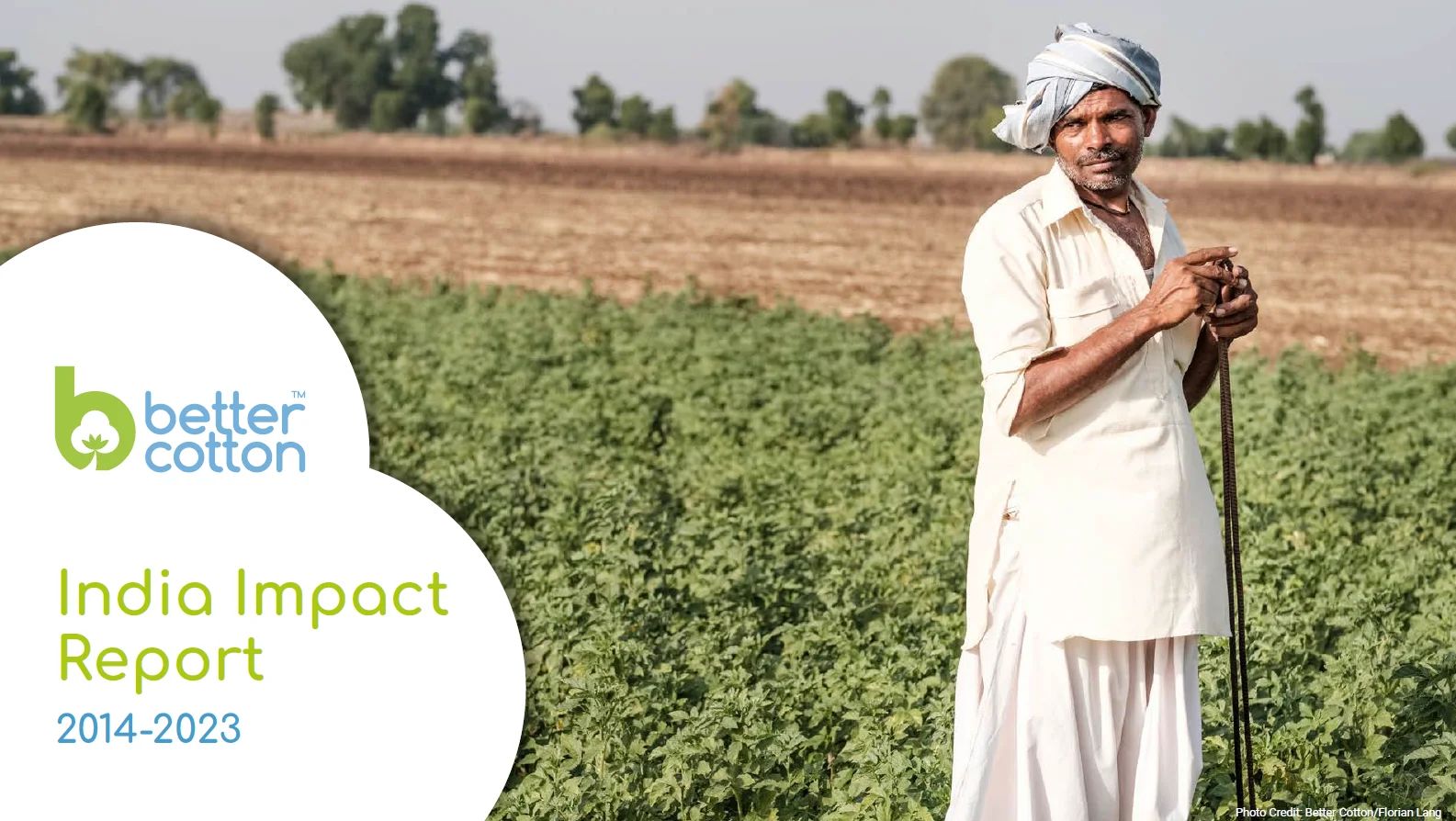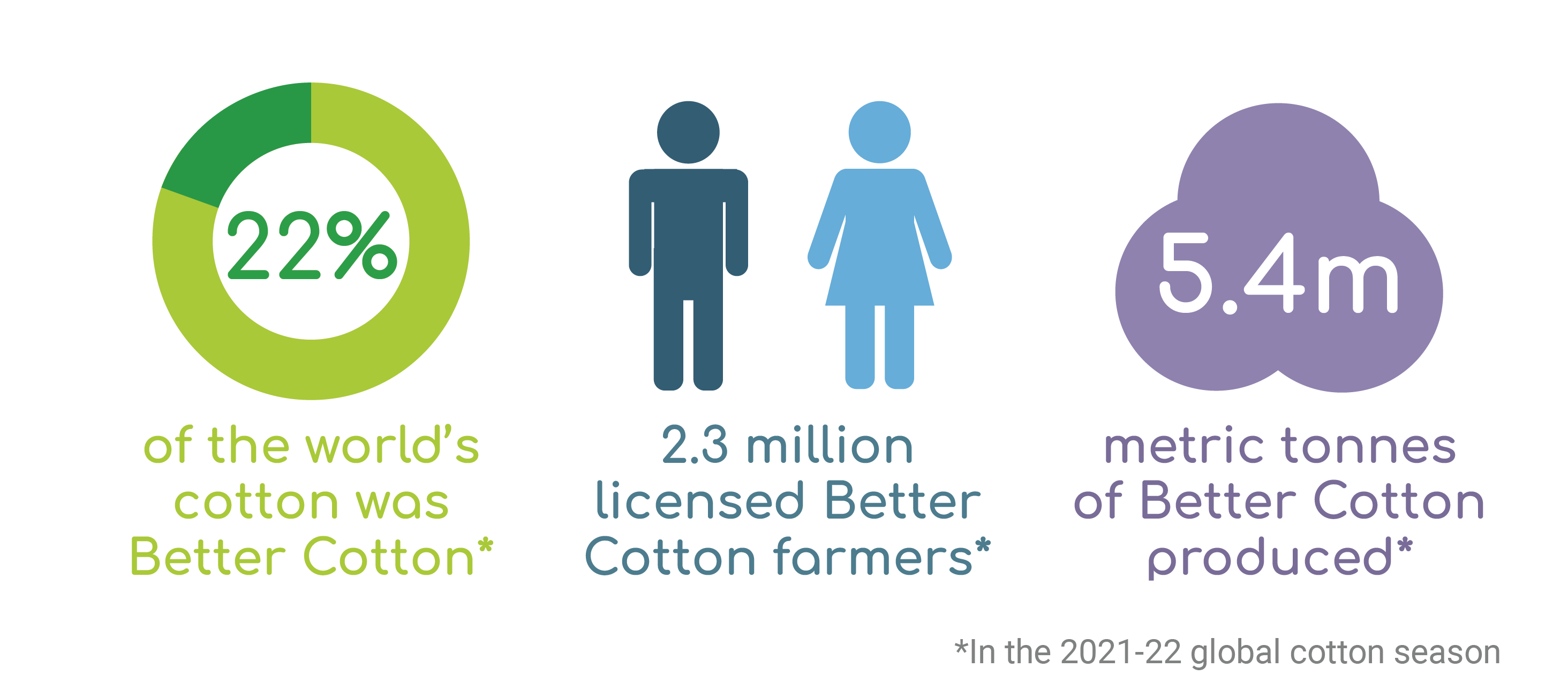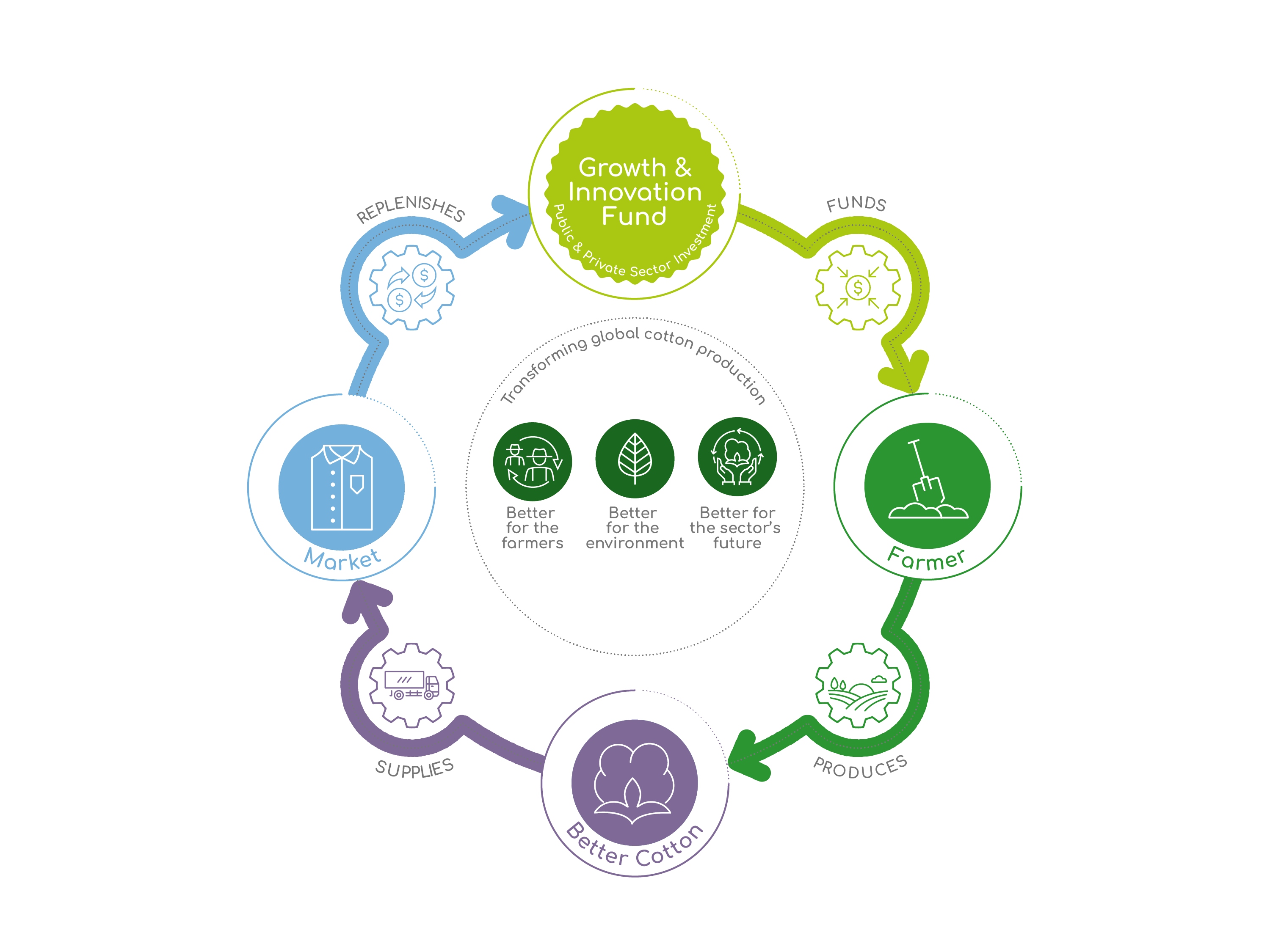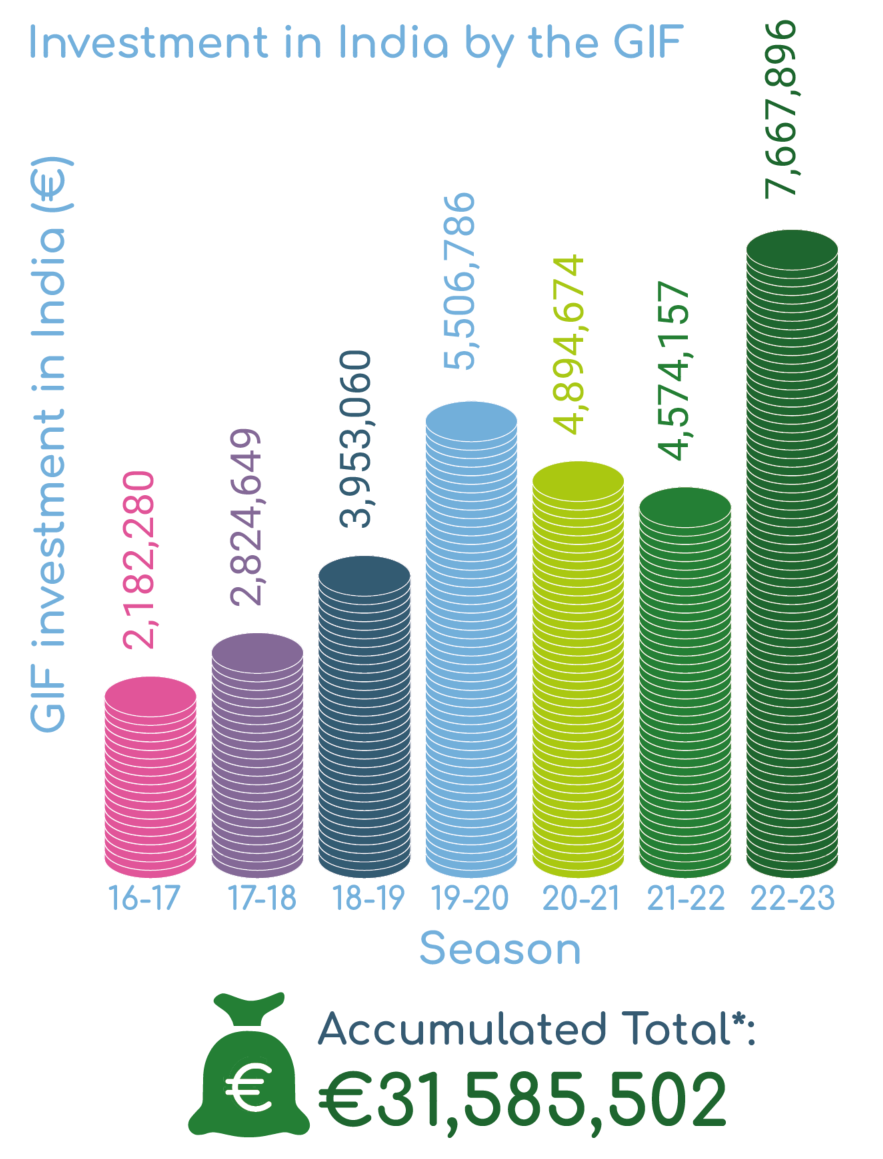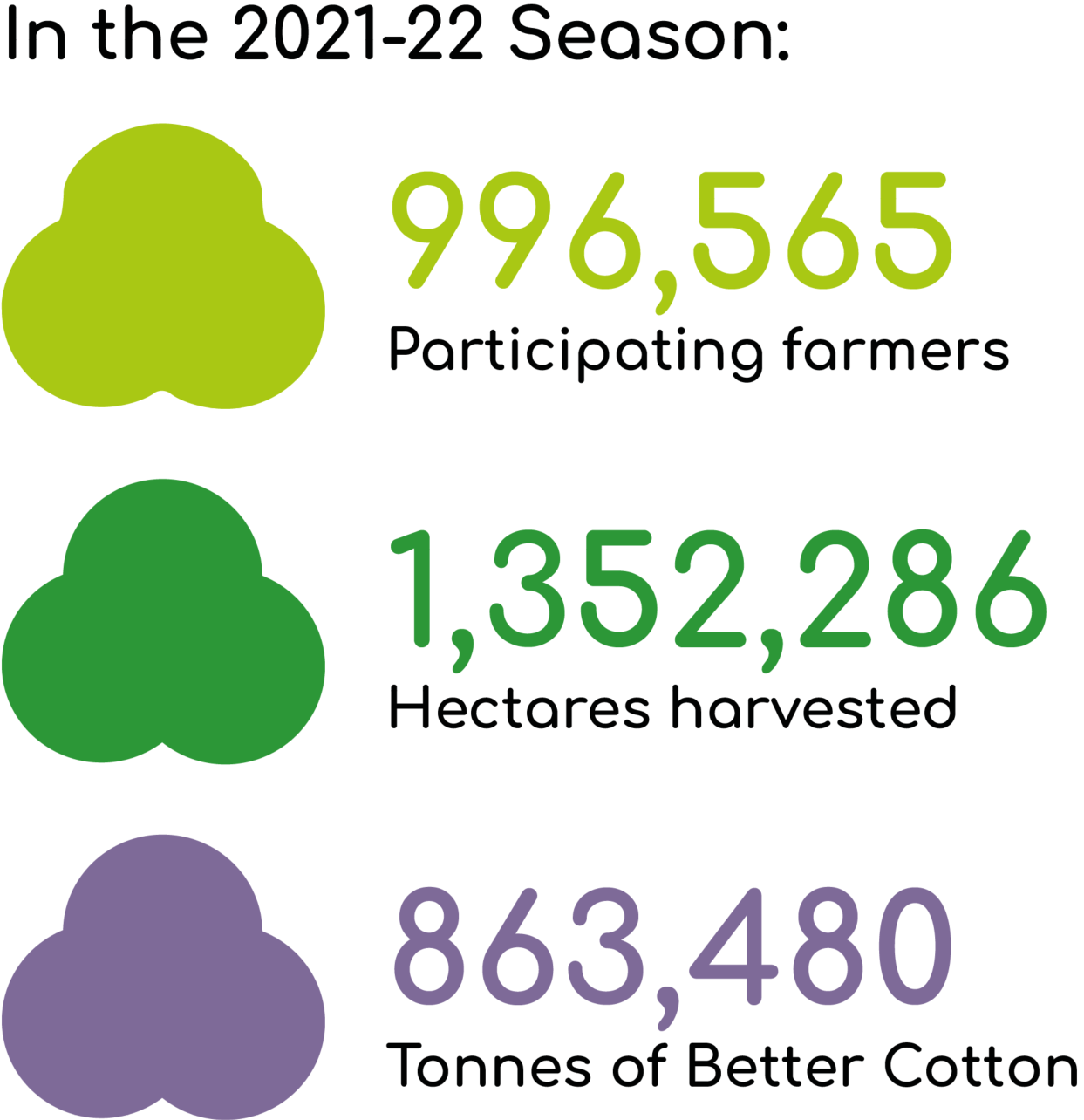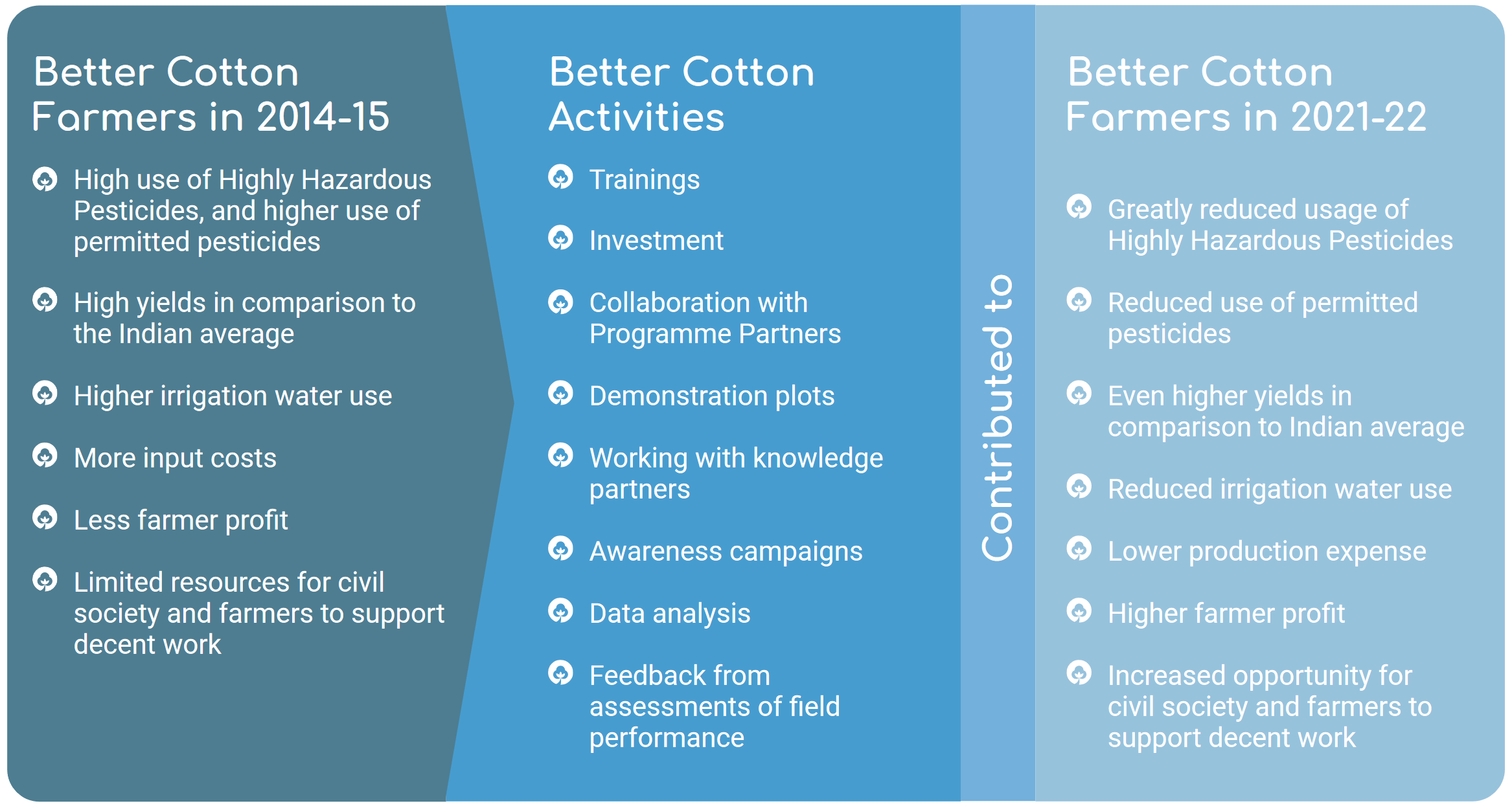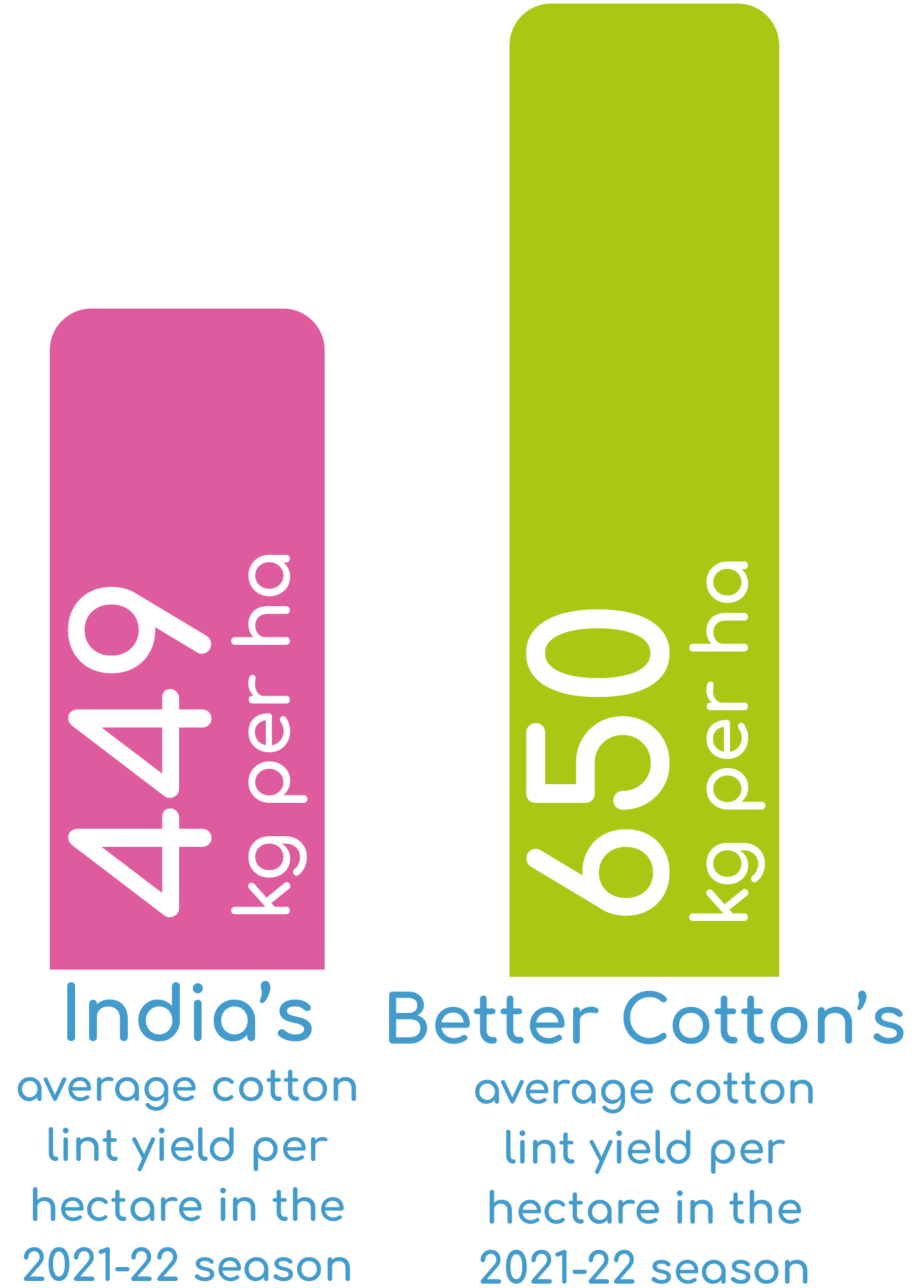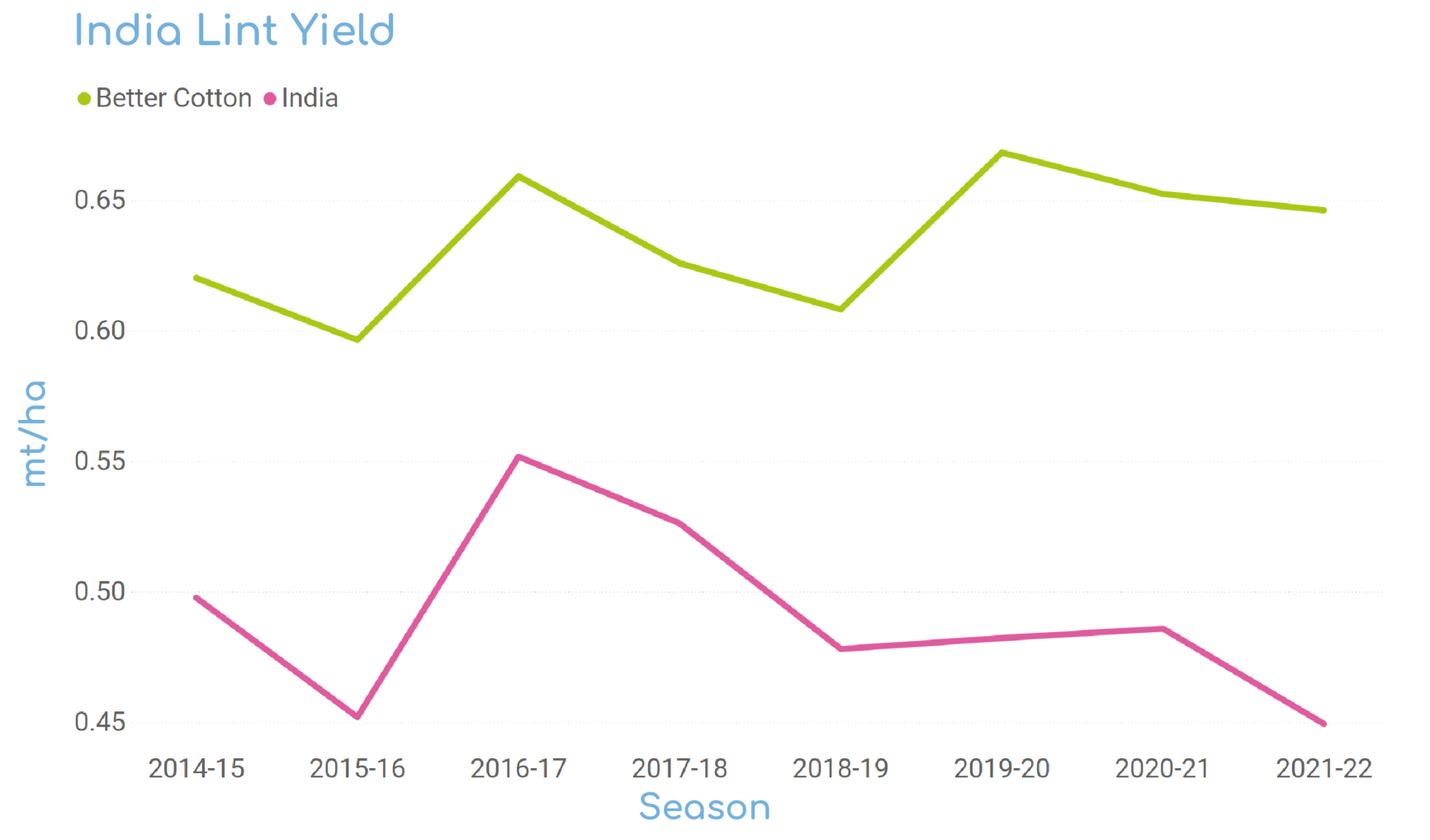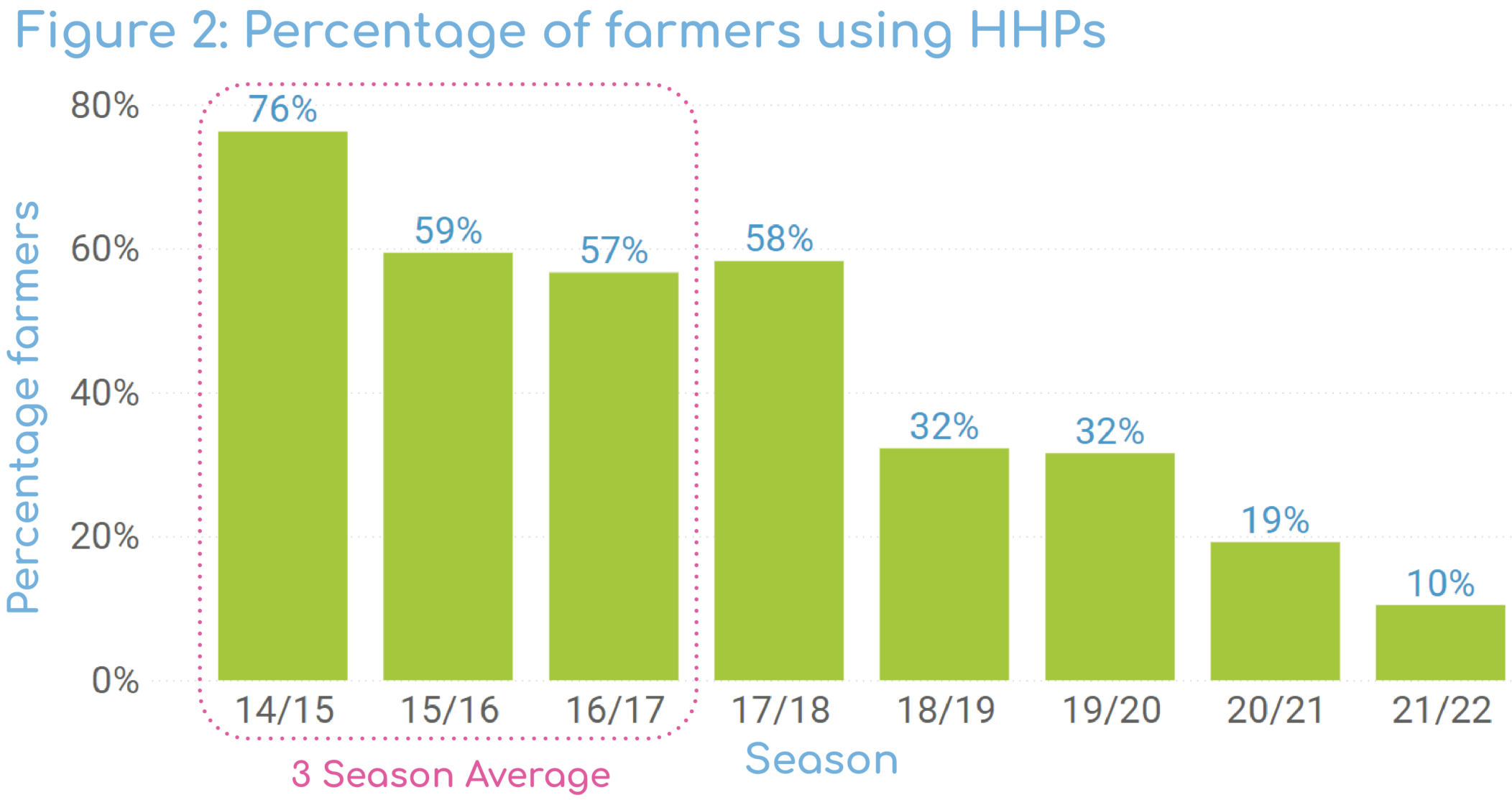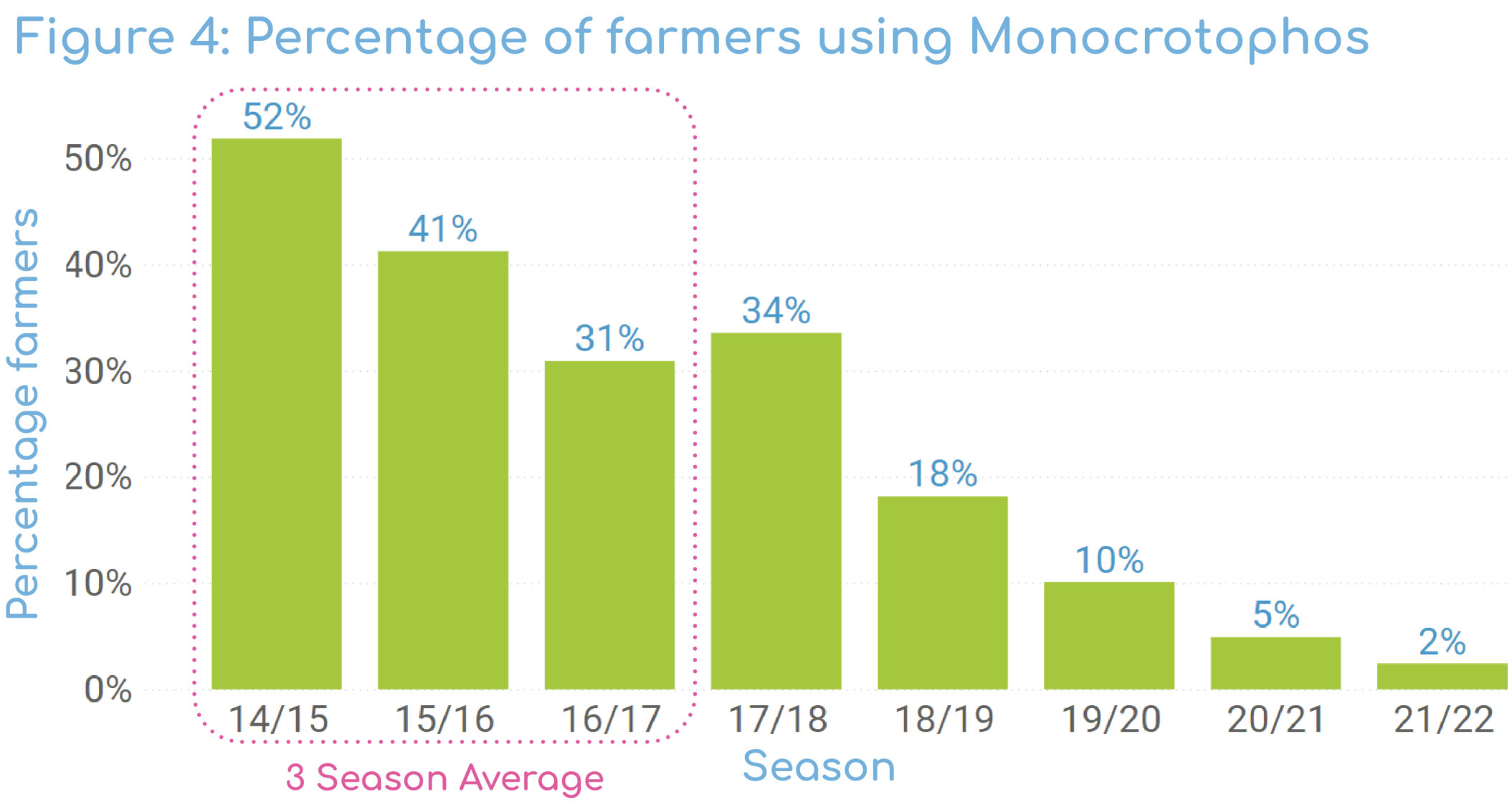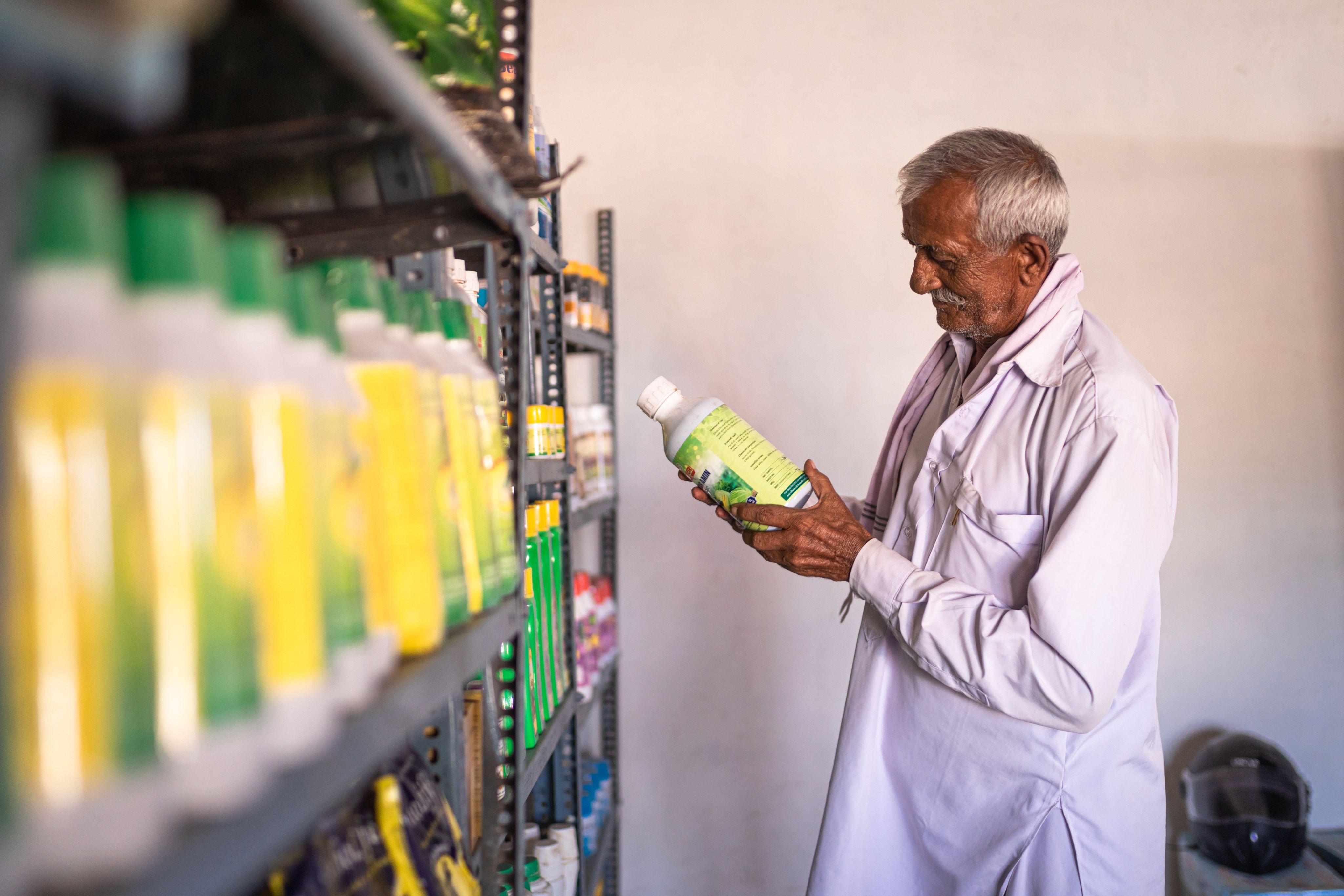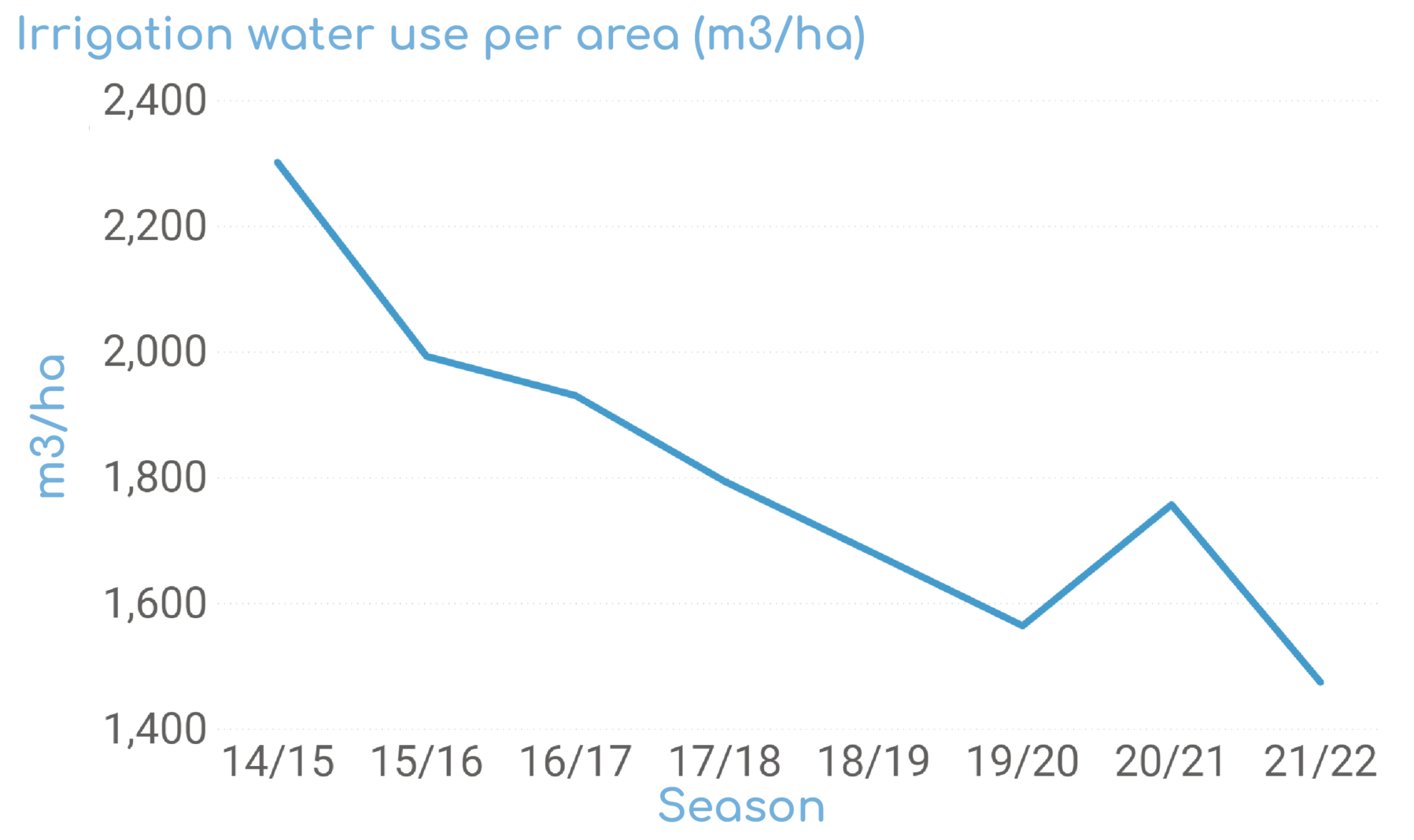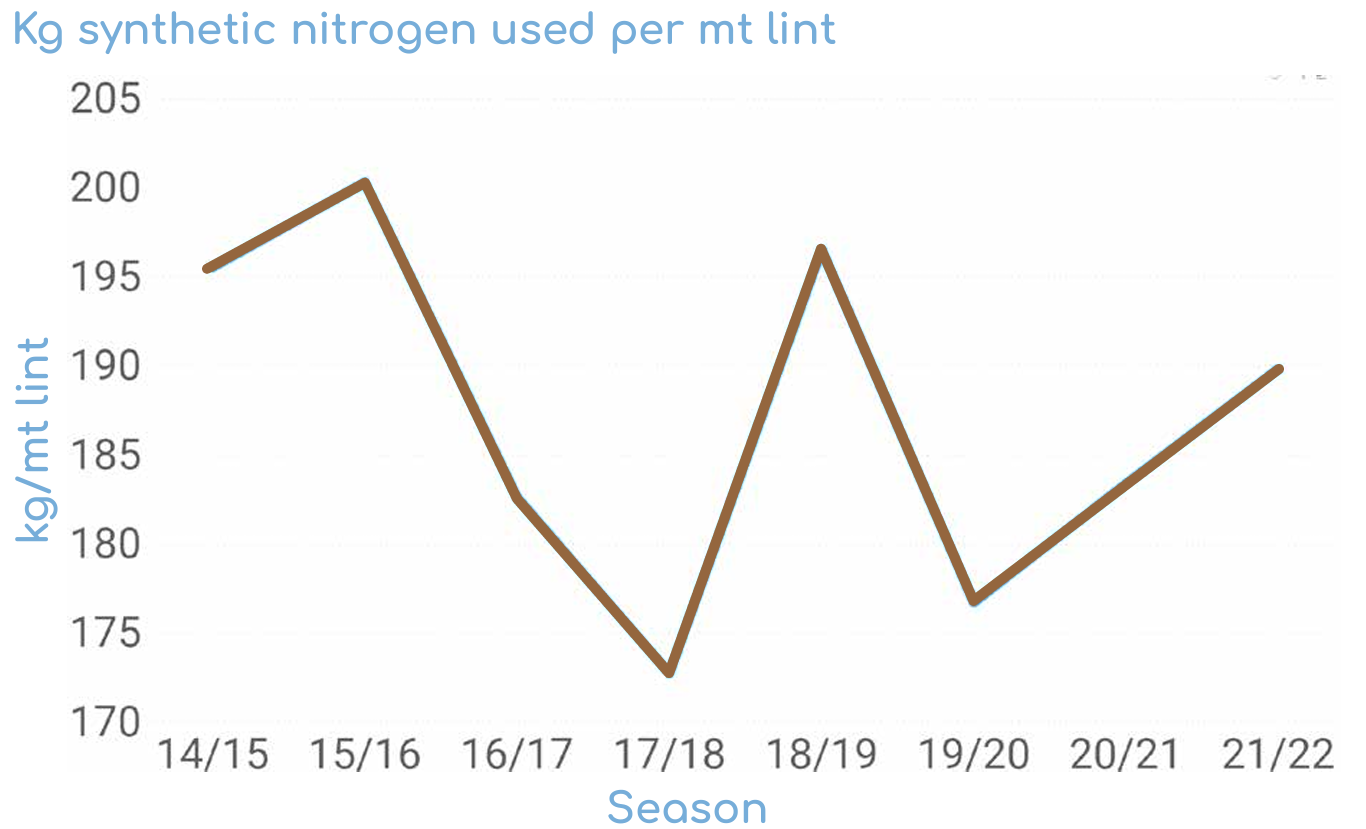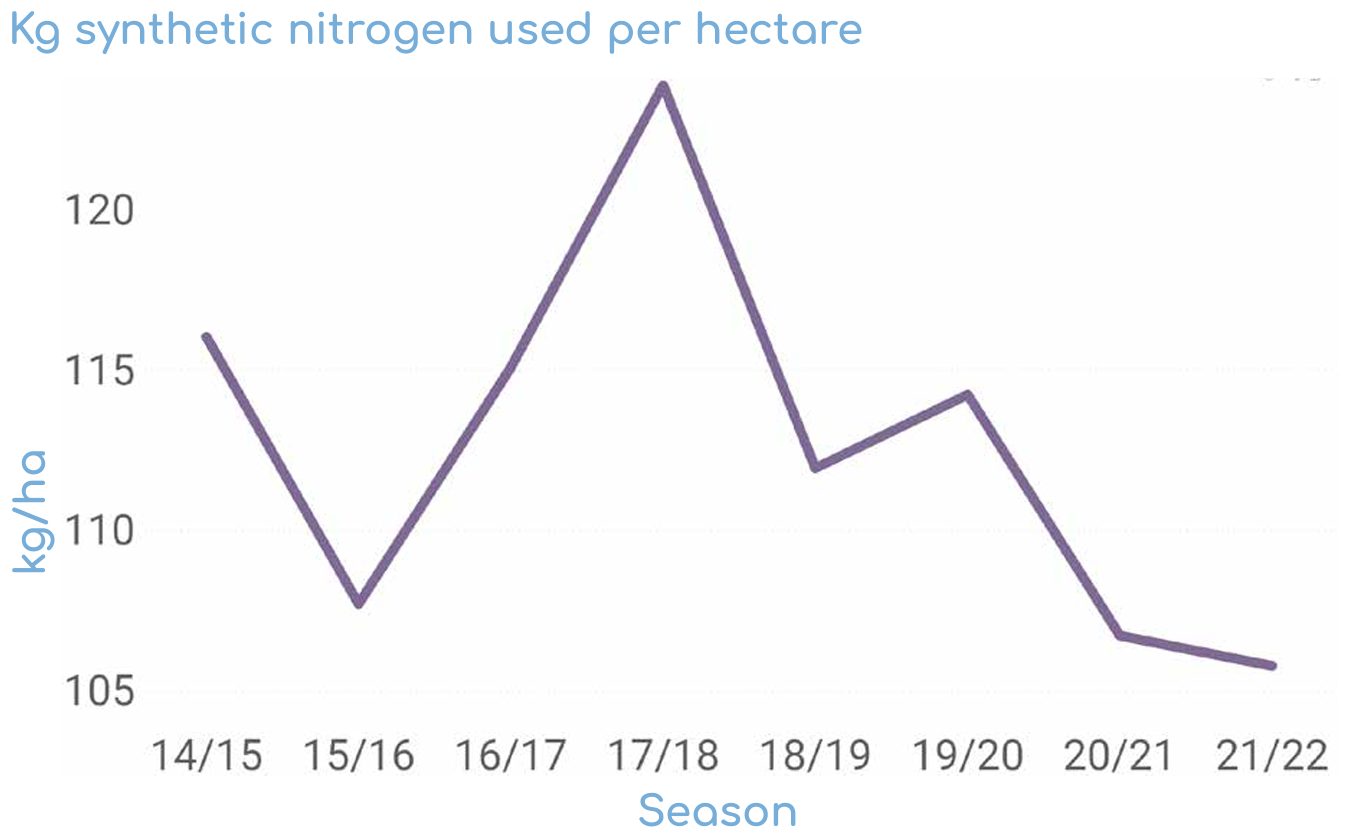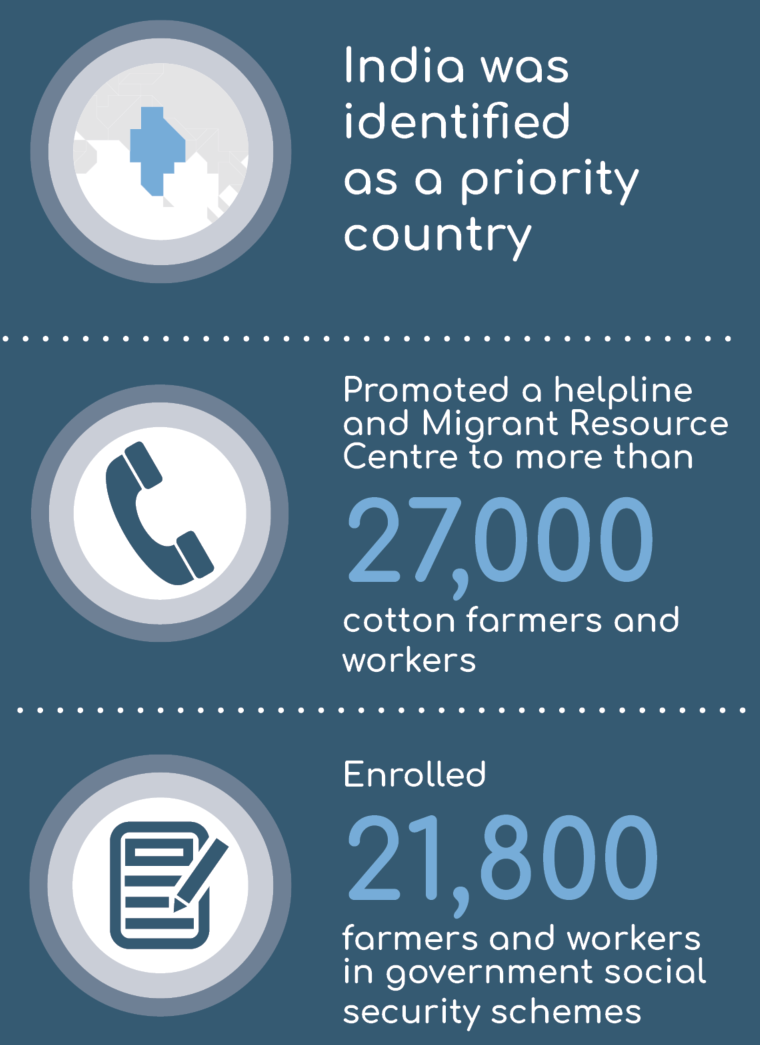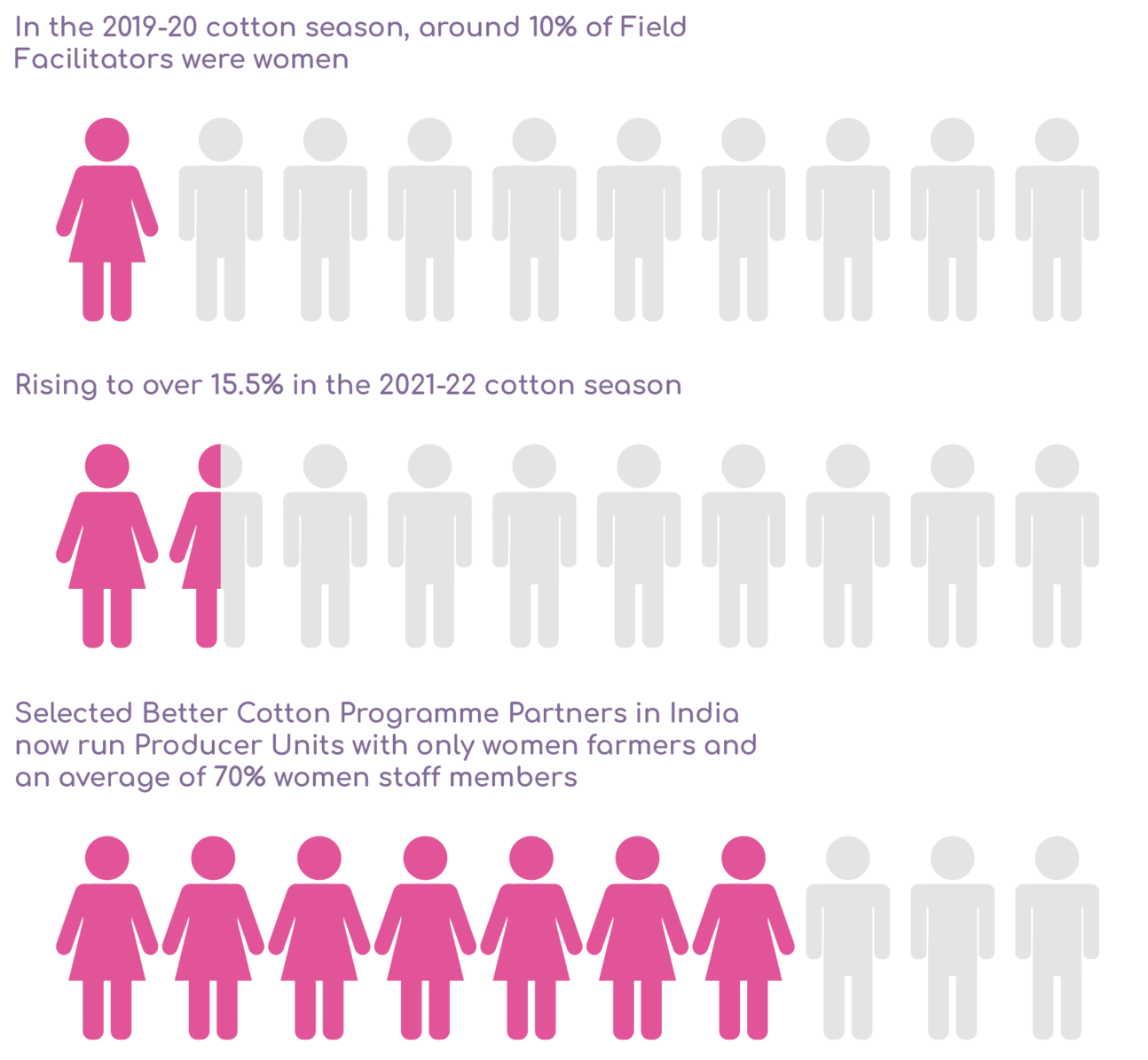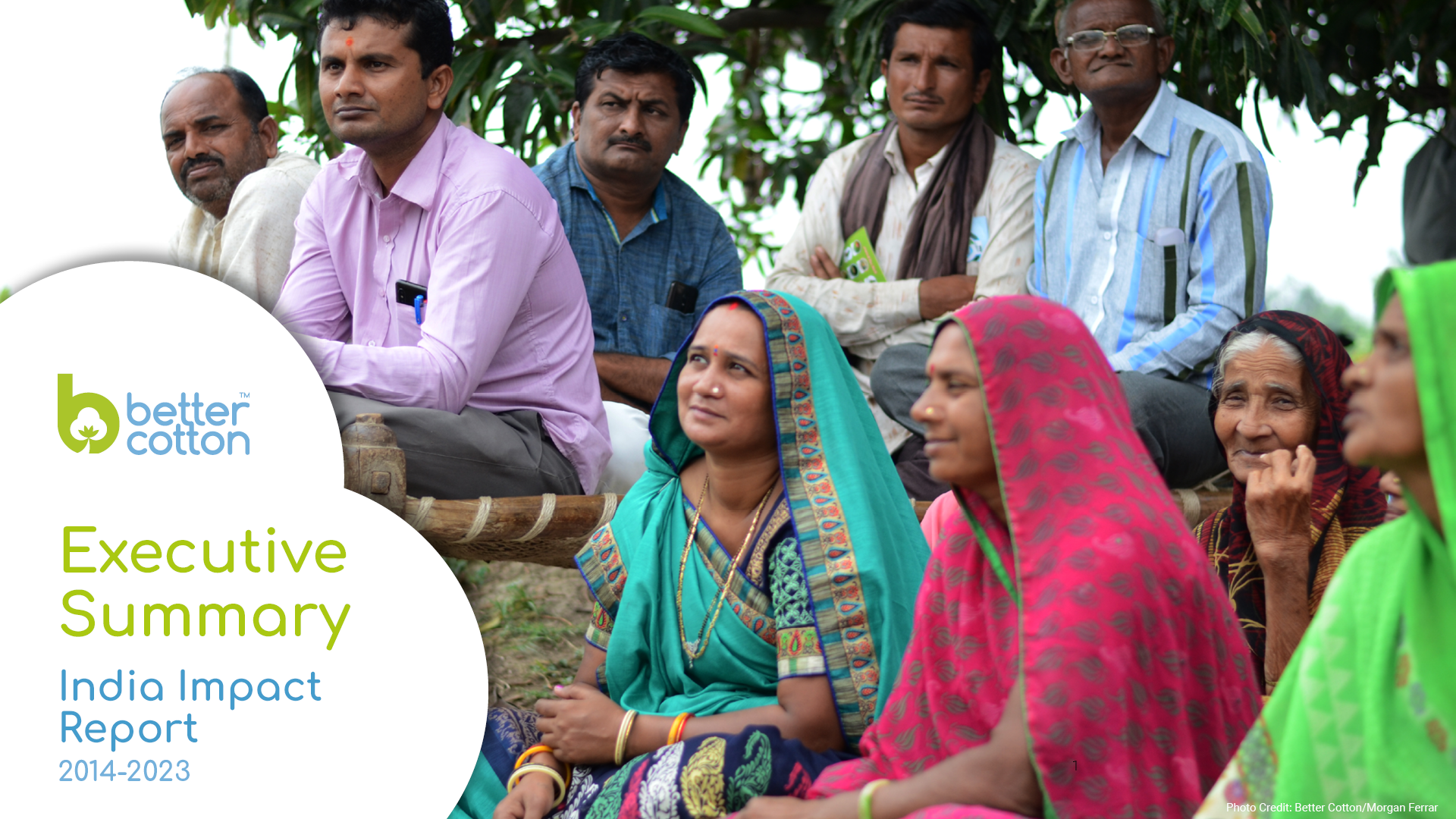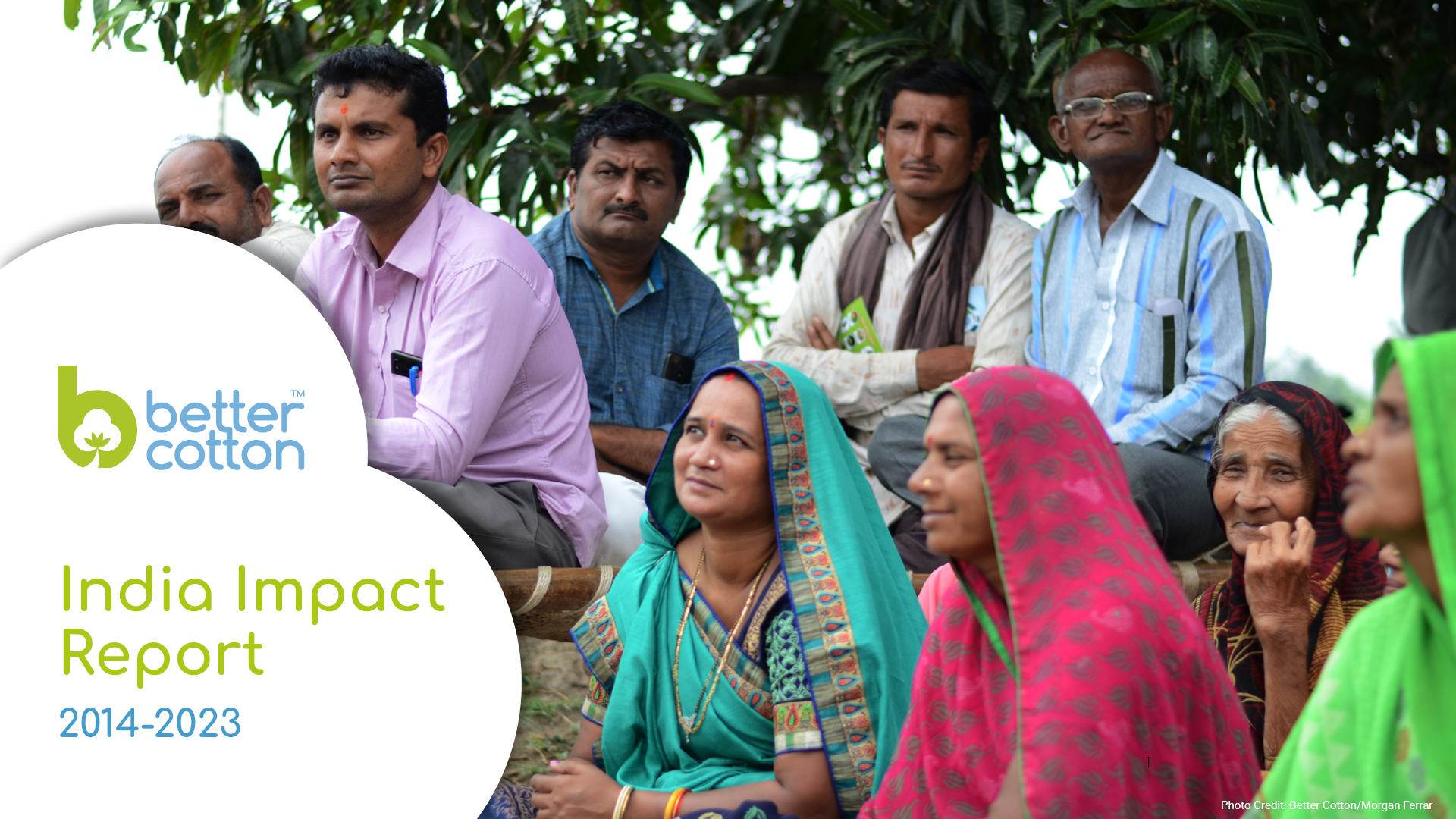India Impact Report
2014 - 2023
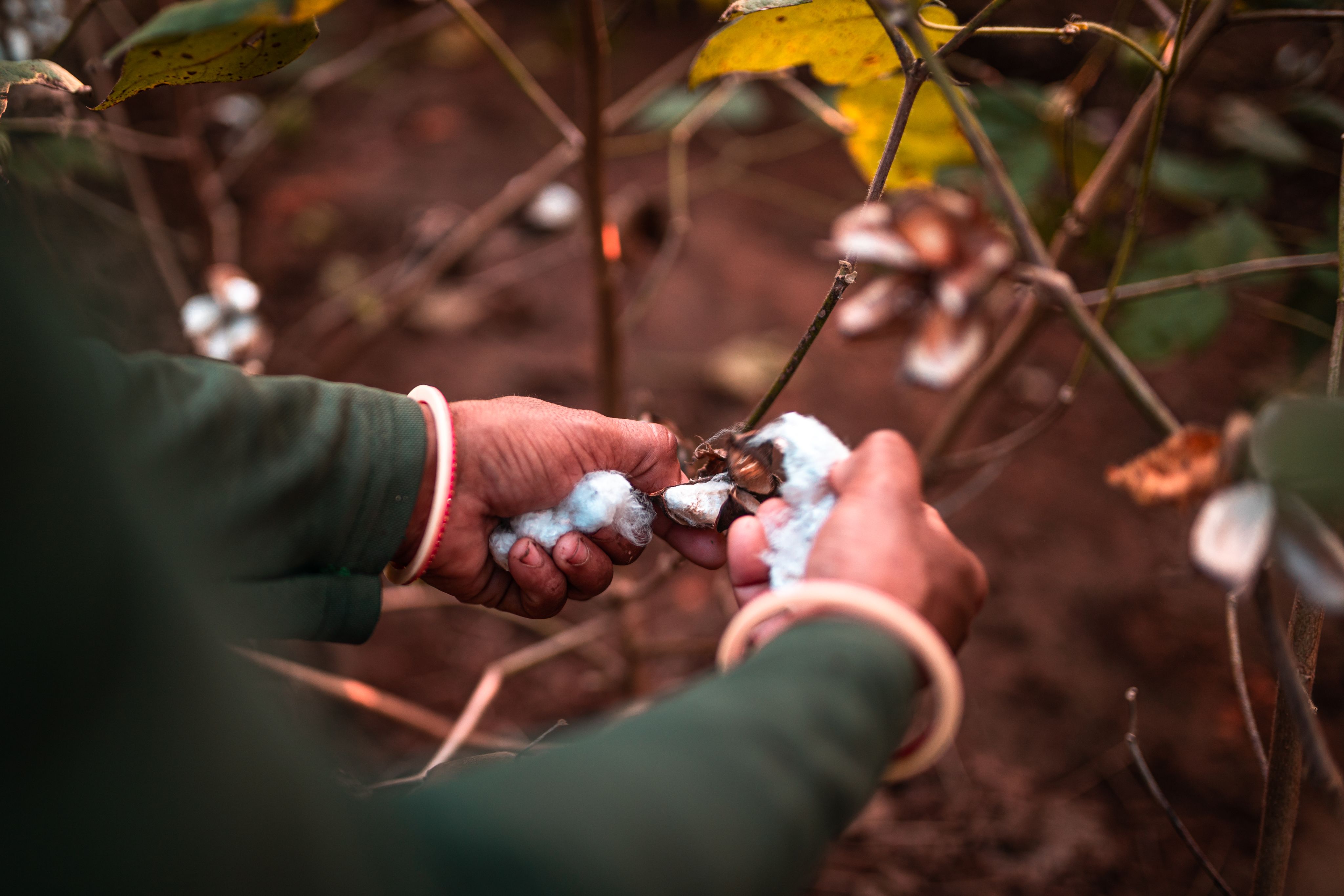
View the Executive Summary here:
View the Full Report here:
Better Cotton in India
Since the first Better Cotton harvest in India in 2011, the country has been a pioneering force within the global Better Cotton Programme.
Starting with 22,314 participating farmers, the programme has expanded rapidly to nearly one million farmers as of the 2021-22 cotton season — the largest number from any Better Cotton growing country.
These farmers grow on almost 1.3 million hectares of land spread across seven states, with the crop serving as a core component of many local economies.
**In the 2021-22 India cotton season
Global Reach
In the 2021-22 cotton season, Better Cotton was grown in 23 countries around the world and accounted for 22% of global cotton production.
Our India Programme
Strengthening Capacity
Helping farmers survive and thrive is central to our mission at Better Cotton. Achieving that mission starts with strengthening the capacity of farmers on the ground to adopt more sustainable practices. Our Capacity Strengthening Programme in India puts farmers and farm workers front and centre.
In the 2022-23 cotton season, Better Cotton Programme Partners provided around 2,000 trainings, replicated within smaller learning groups of participating farmers, that reached almost 1 million farmers on topics like Integrated Pest Management, child labour prevention and soil health.
Working with Partners
Our 13 current Programme Partners in India provide training to Better Cotton Farmers on more sustainable practices that help them reduce their input costs, increase their yields and fibre quality and safeguard their wellbeing.
Our Partners:
- Aga Khan Rural Support Programme India
- Ambuja Cement Foundation
- Arvind Ltd.
- Action for Food Production (AFPRO)
- Basil Commodities Pvt. Ltd. (Basil Group)
- CottonConnect India
- Deshpande Foundation
- Development Support Centre
- Lupin Human Welfare and Research Foundation
- Vardhman Textiles
- Spectrum International (SIPL)
- Welspun Foundation for Health and Knowledge (WFHK)
- WWF India
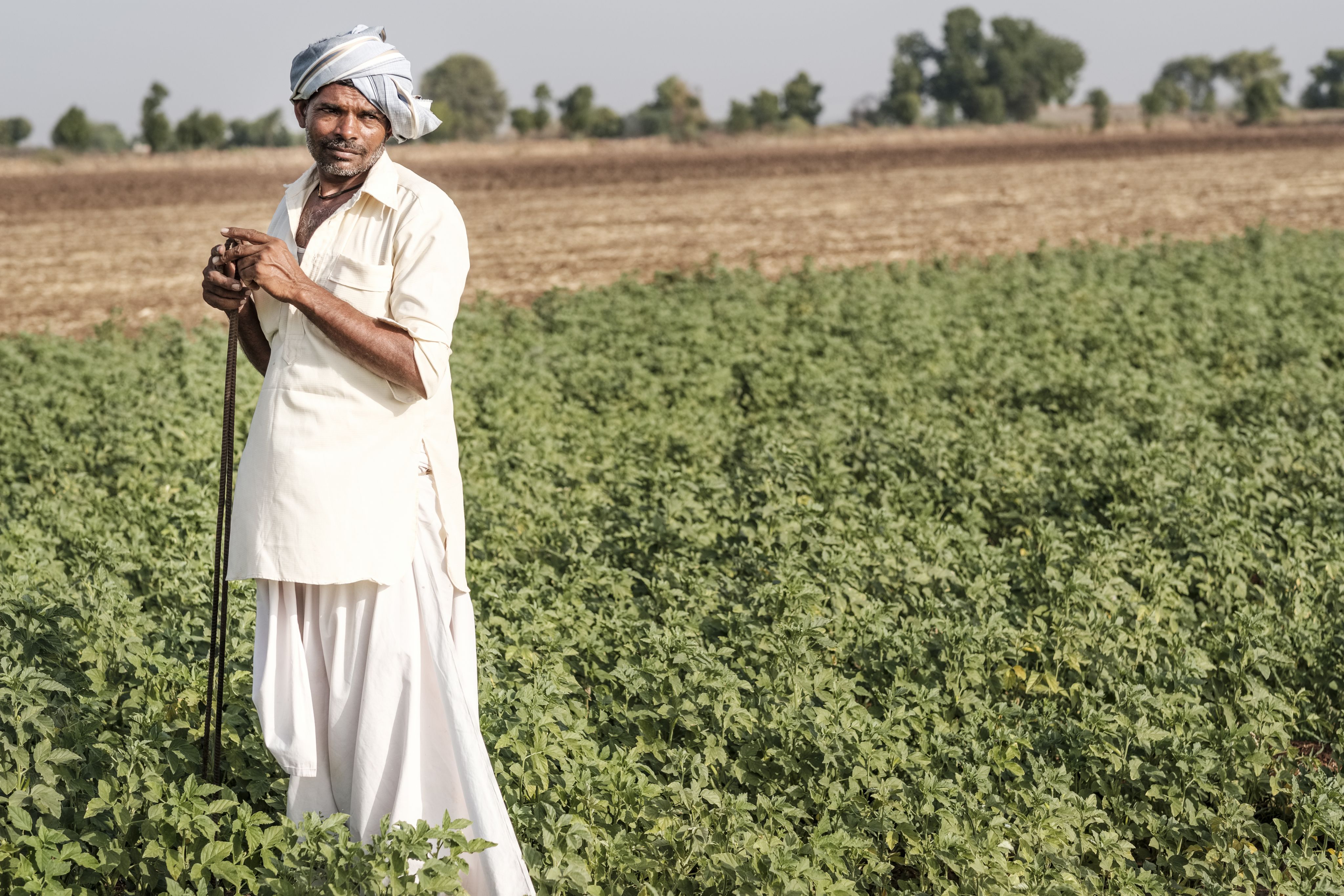
Impact in Action
Bapu Rama Marathe, Dahyane village, Dhule, Maharashtra
- Better Cotton Farmer since 2018
Bapu owns five acres of land, two of which are cotton cultivated. Over-fertilisation and indiscriminate sprays of pesticides have been traditionally used by farmers in his region to boost their yields in cotton, which had a negative impact on the crop and added to farming expenses. The region also suffers from the impacts of climate changes including uneven rainfall pattern, high temperatures and lack of ground water availability, which has an impact on soil and crop health.
Attending Better Cotton trainings has helped Bapu to apply innovative farming methods to overcome these challenges. He learnt how to make bio-preparations and actively applied it on his field over the season.
He now prepares different natural pesticides like Jivamrut, Amrutpani, Panchgavya and homemade amino acid and humic acid to apply in his fields. In the 2020-21 cotton season, Bapu did not use any chemical spray on his field and he performed soil testing on his farms to ensure correct treatment for his crop.
"Before joining Better Cotton, I didn’t take soil testing seriously. After interacting with the Field Facilitator from Better Cotton, I learnt about soil testing and its practical benefits for a smallholder farmer like me. Now, I apply fertiliser doses according to the soil requirement of my farm. This practice increases my production, improves soil fertility, enhances availability of nutrients in soil and decreases my cost of cultivation."
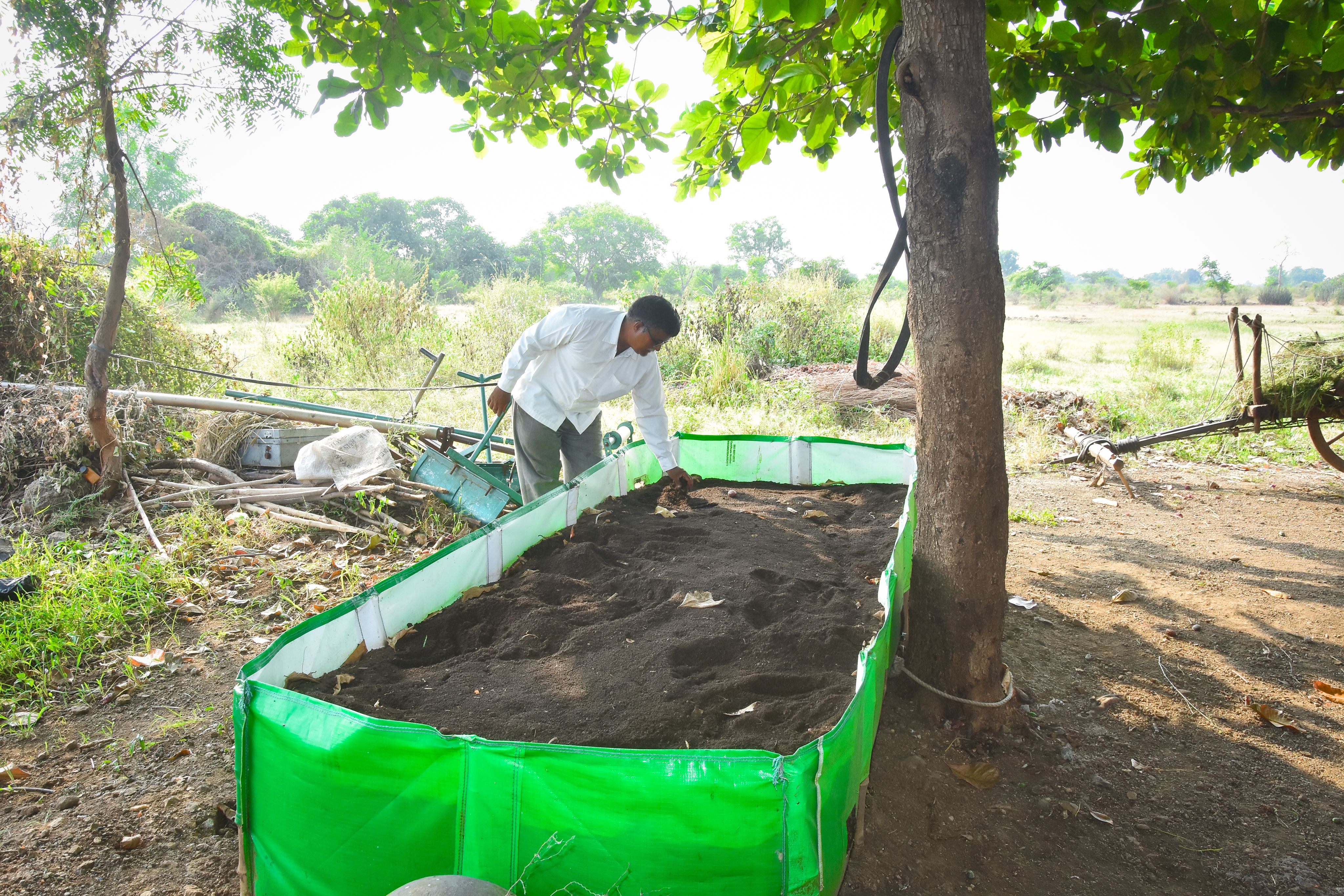

Financing capacity strengthening
Positive change at the field-level cannot happen without the right funding and investments being available to Better Cotton Farmers and farming communities.
That’s why we started the Better Cotton Growth and Innovation Fund in 2016 to drive investments to Better Cotton Farmers and farming communities. The fund identifies, supports and invests in fieldlevel programmes and innovations, mobilising contributions from Retailer and Brand Members, Programme Partners and public and private donors.
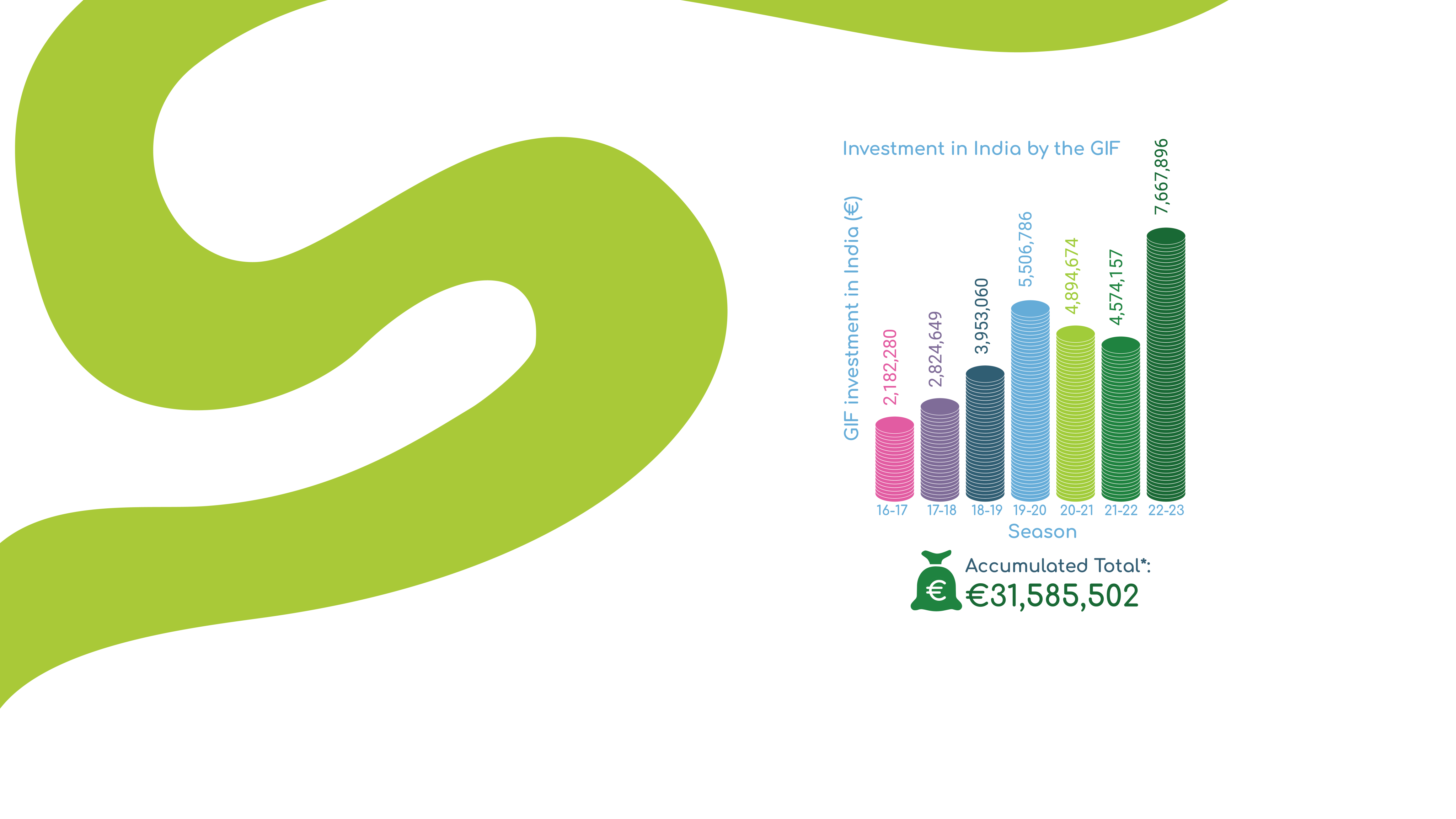
How does the Fund work?
Better Cotton Retailer and Brand Members contribute to the Fund through a fee-based levy dependent on the volume of Better Cotton they procure and declare (Volume-Based Fee or VBF).
This fee enables brands to directly and efficiently support field-level programmes. Additionally, the Better Cotton GIF invites institutional donors and private foundations to match the fees contributed by the private sector.
The Better Cotton GIF also encourages programme partners to contribute to their own projects.
*Investments prior to the 2016-17 season were part of the Fast Track Programme managed by IDH.
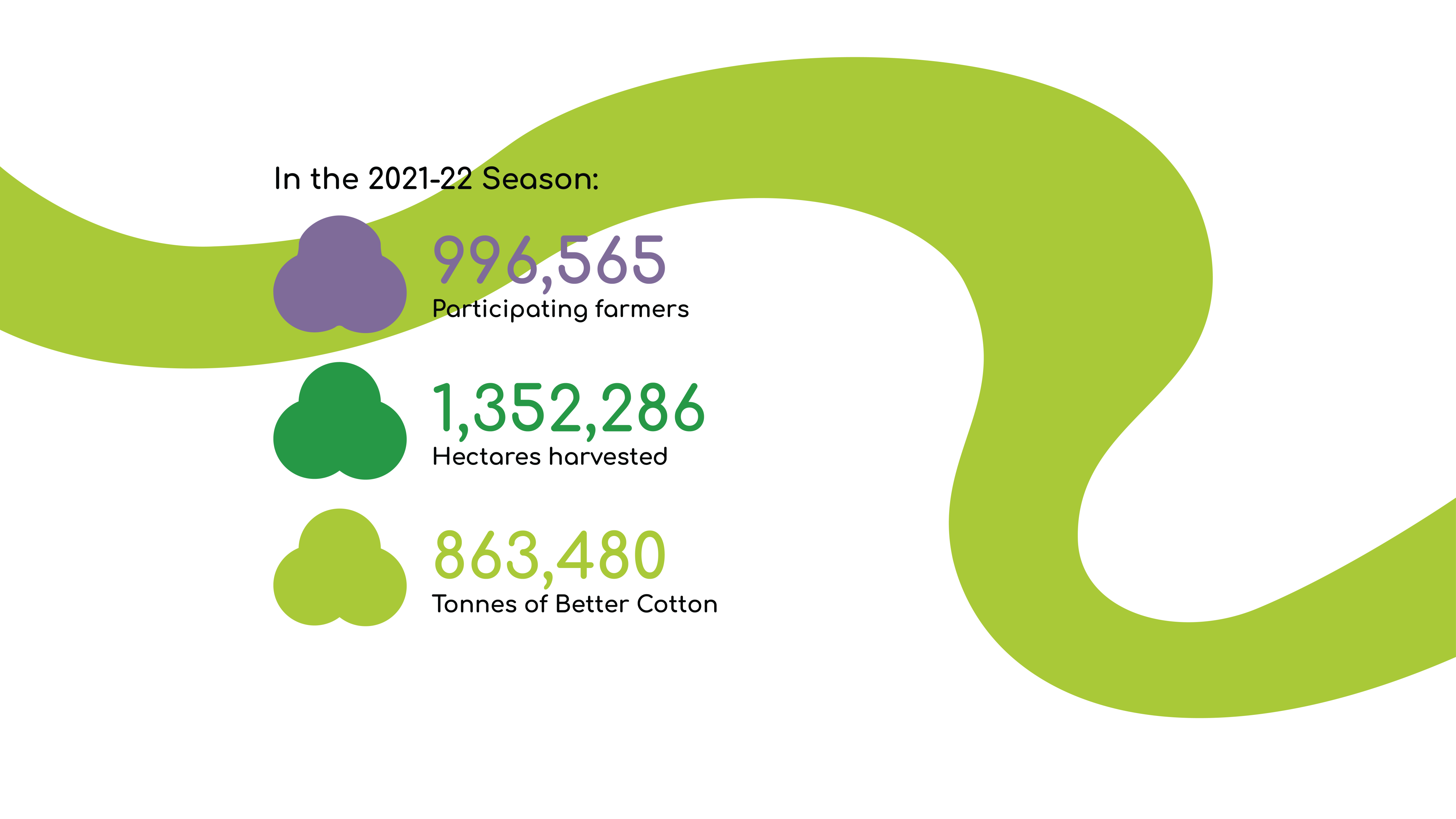
Measuring Impact
This report represents a departure from Better Cotton’s past results reporting in which we compared Better Cotton Farmers’ average results to those of nonparticipating farmers growing cotton in the same areas during the same season.
Over the past 18 months, Better Cotton has overhauled its data management system to examine the performance of Better Cotton Farmers over a multi-year timeframe with enhanced contextual reporting.
This, combined with data from the past eight seasons, enables us to share trends for Better Cotton Farmers.
Due to the myriad natural and other external factors affecting agriculture and labour dynamics, we cannot say that all trends are happening because of Better Cotton. In many cases, however, we have evidence that the programme, in partnership with local expert organisations, is contributing to positive change.
Financing capacity strengthening
Positive change at the field-level cannot happen without the right funding and investments being available to Better Cotton Farmers and farming communities.
That’s why we started the Better Cotton Growth and Innovation Fund in 2016 to drive investments to Better Cotton Farmers and farming communities. The fund identifies, supports and invests in fieldlevel programmes and innovations, mobilising contributions from Retailer and Brand Members, Programme Partners and public and private donors.
How does the Fund work?
Better Cotton Retailer and Brand Members contribute to the Fund through a fee-based levy dependent on the volume of Better Cotton they procure and declare (Volume-Based Fee or VBF).
This fee enables brands to directly and efficiently support field-level programmes. Additionally, the Better Cotton GIF invites institutional donors and private foundations to match the fees contributed by the private sector.
The Better Cotton GIF also encourages programme partners to contribute to their own projects.
*Investments prior to the 2016-17 season were part of the Fast Track Programme managed by IDH.
Measuring Impact
This report represents a departure from Better Cotton’s past results reporting in which we compared Better Cotton Farmers’ average results to those of nonparticipating farmers growing cotton in the same areas during the same season.
Over the past 18 months, Better Cotton has overhauled its data management system to examine the performance of Better Cotton Farmers over a multi-year timeframe with enhanced contextual reporting.
This, combined with data from the past eight seasons, enables us to share trends for Better Cotton Farmers.
Due to the myriad natural and other external factors affecting agriculture and labour dynamics, we cannot say that all trends are happening because of Better Cotton. In many cases, however, we have evidence that the programme, in partnership with local expert organisations, is contributing to positive change.
Trends
“India is a crucial cotton- producing country and has been a priority for us for many years. So, we at Better Cotton are hugely encouraged by these impressive results from our India programme.
From pesticides to yields, water to decent work, these results show the considerable impact that giving farmers and farm workers access to the necessary tools, training and support can have on the sustainability of the cotton sector.”
- Jyoti Narain Kapoor, India Country Director, Better Cotton
Yields
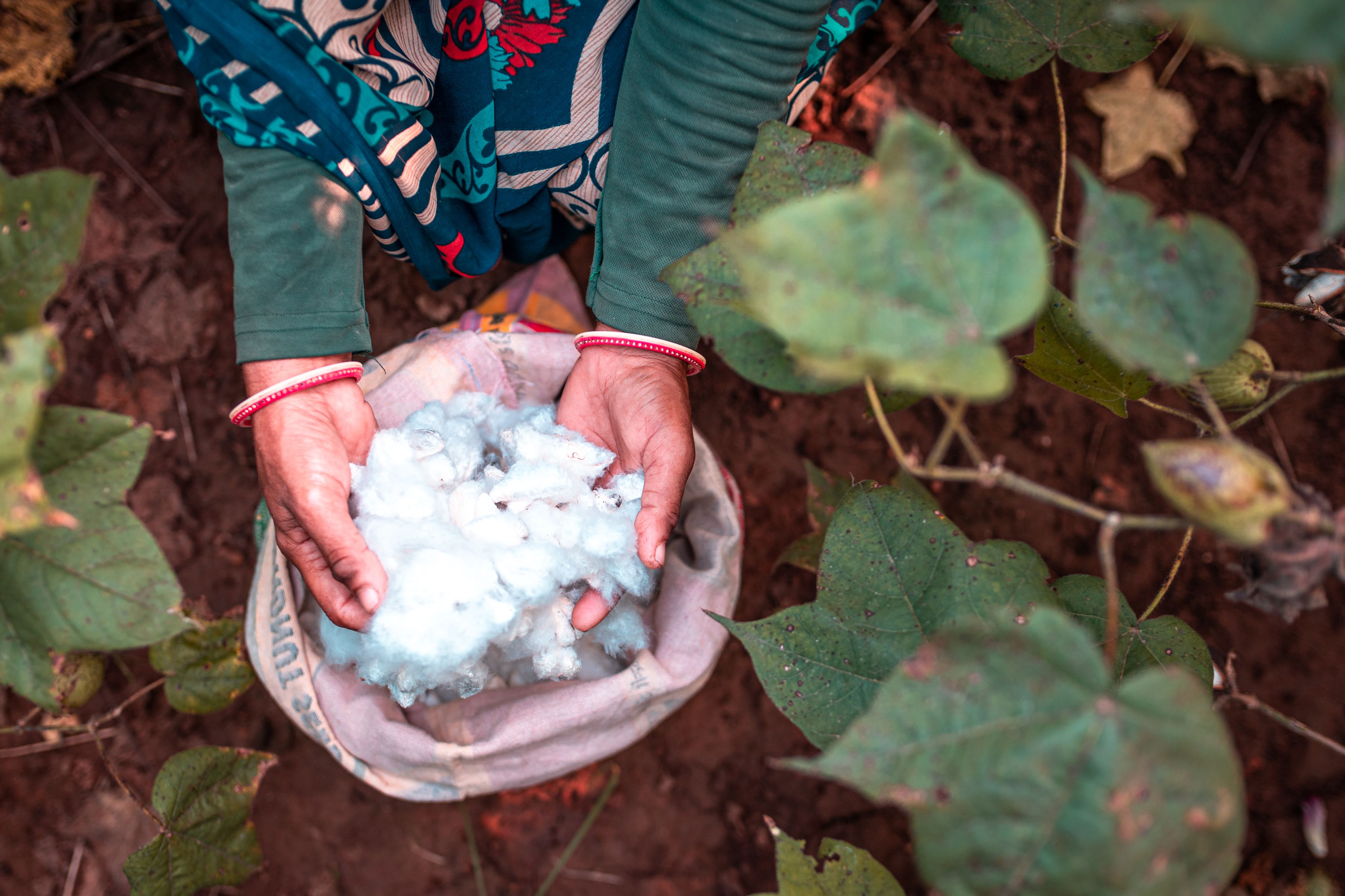
Better Cotton and our Programme Partners in India support farmers to implement more sustainable agricultural practices that can help them not only boost their yields but also make them more resilient to challenges presented by changing weather patterns, increasing and varying pests and economic instability.
In 2021-22 season, the country’s average cotton lint yield was 449 kg per hectare, Better Cotton yields reached 650 kg per hectare, in part likely due to the higher proportion of irrigated farms in Better Cotton’s Programme compared to the national average. Despite complex comparison of yield evolution due to its multifactorial dependence, the increasing trend of yields are positive results, and we will continue to monitor this important indicator for livelihoods and the strength of the sector.
Pesticide Use
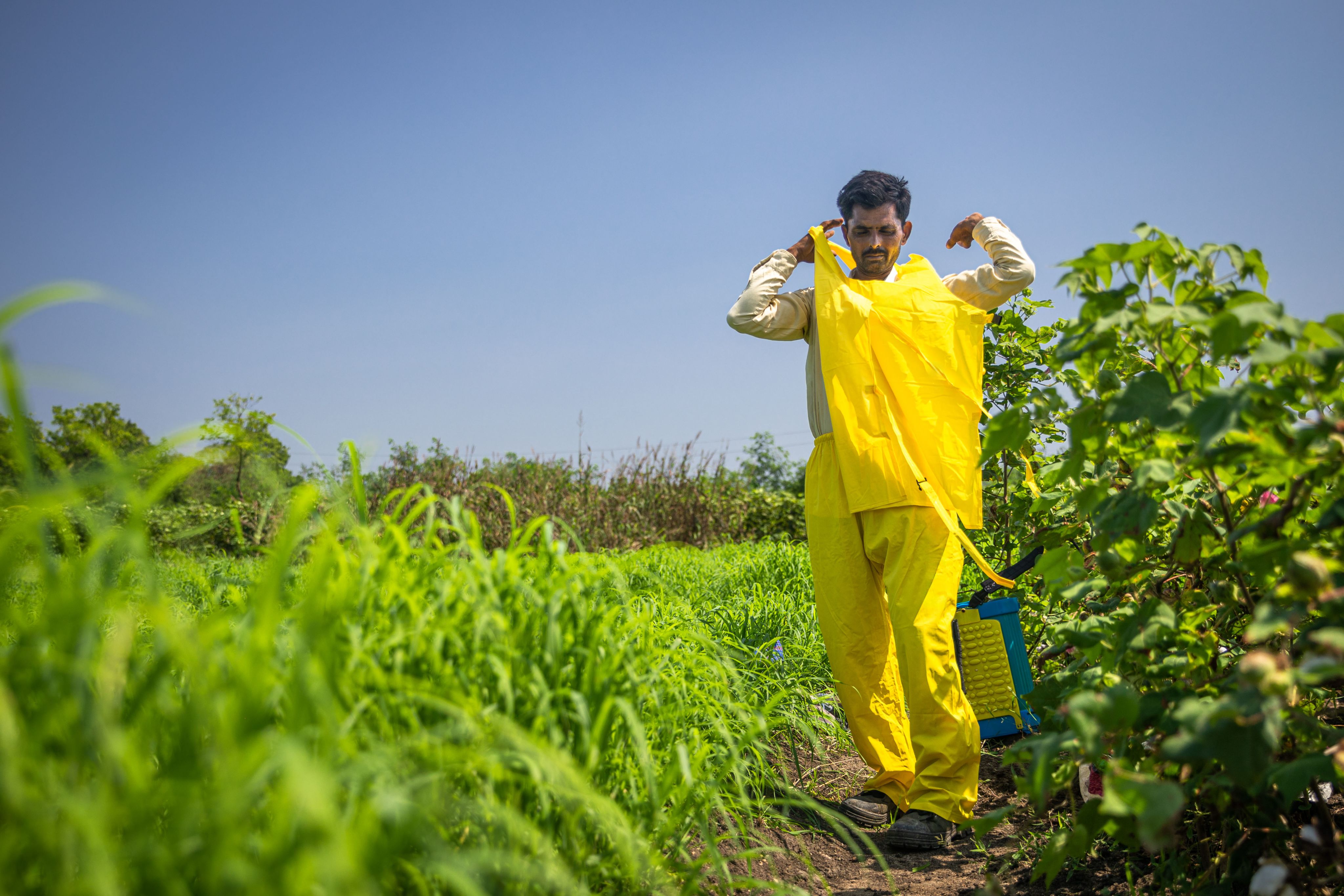
Cotton farmers across India struggle with pests, particularly pink bollworm which has plagued cotton-growing areas in recent years. This has made pesticide use common, including the use of ‘pesticide cocktails’ (made by mixing two or more active ingredients), which are aggressively marketed by pesticide dealers to smallholders. To address these issues, our Programme Partners in India raise awareness of, and encourage cotton farmers to adopt an Integrated Pest Management (IPM) approach that is fundamental to reduce reliance on synthetic pesticides.
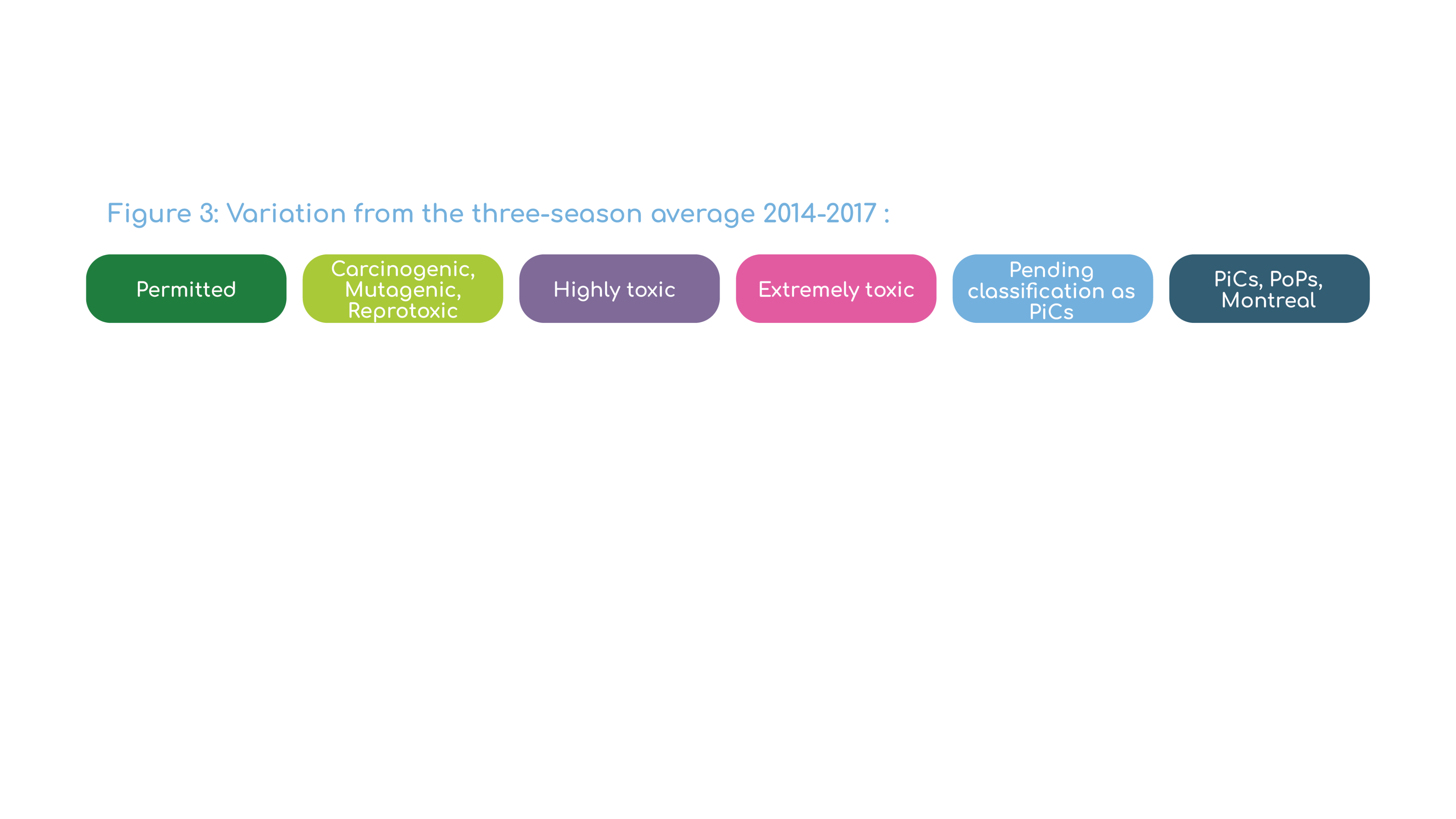
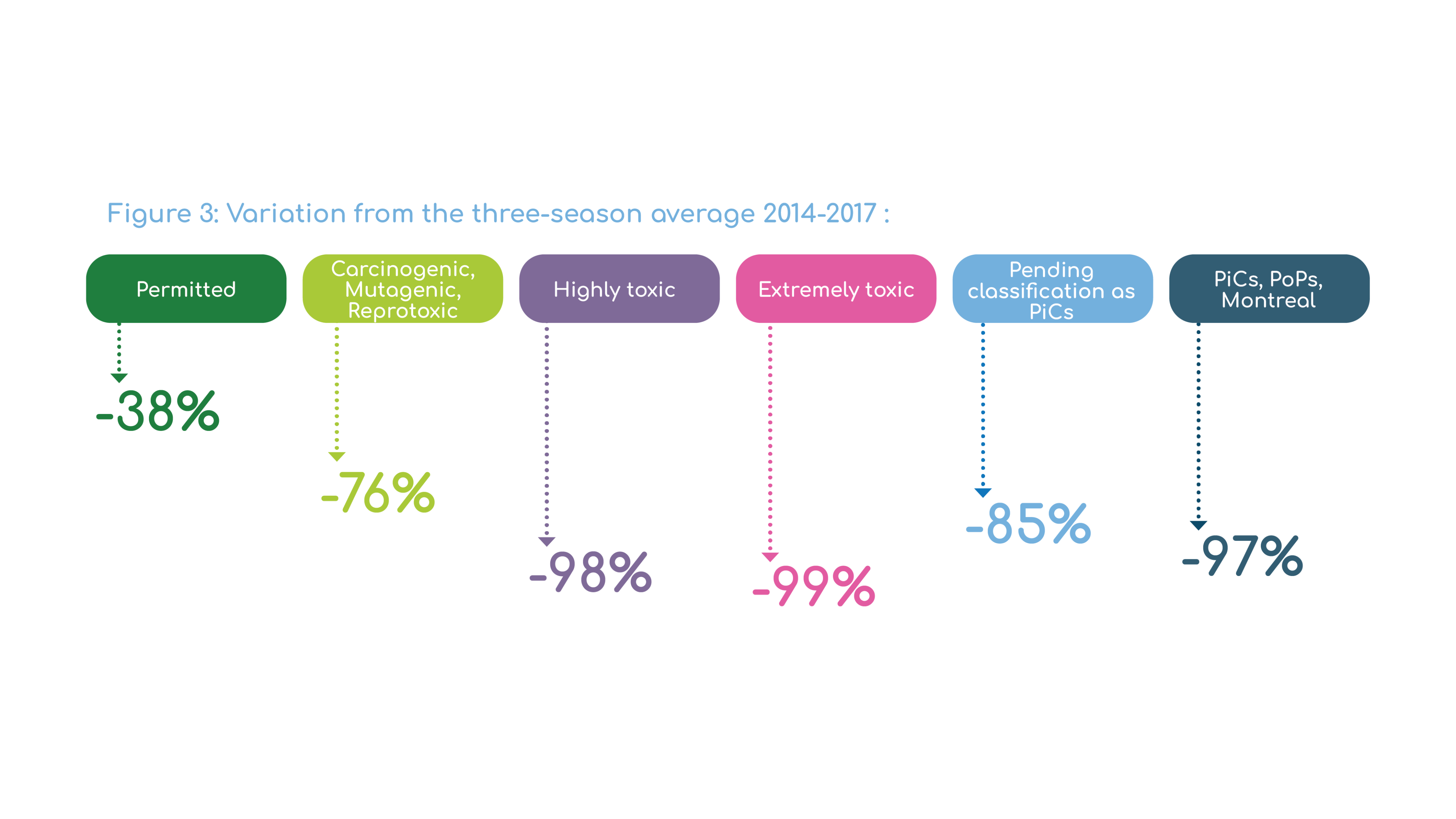
Pesticide Cocktail Awareness Campaign
Through this multi-year campaign across all areas of India where Better Cotton works, we aimed to raise awareness of the harmful impact of pesticide cocktails on human health and the environment, providing expert advice and enabling farmers to share experiences. An awareness video was created and used for capacity strengthening among partners, field staff, farmers and farm workers, and forms a base for further training.
This has yielded impressive results. In the 2021-22 cotton season, the total reported volumes used of pesticides among Better Cotton Farmers decreased significantly, by around 53% compared to the three-season average (2014-15, 2015-16 and 2016-17). At the same time, reported Highly Hazardous Pesticide (HHP) use plummeted — from 64% across the three-season average to 10% in the 2021-22 season.
With the support of our Programme Partners, we have also made a dedicated effort to eliminate the use of Monocrotophos on Better Cotton Farms in India, a pesticide classified as highly toxic by the World Health Organization and listed in Annex 3 of the Rotterdam Convention. As a result, Monocrotophos use has dropped significantly in Better Cotton project areas — from 41% of farmers across the three-season average to only 2% in the 2021-22 season.
These results are a strong endorsement of the Better Cotton Programme in India. While there is more work to be done, we feel confident that we are headed in the right direction.
Water and Soil Health
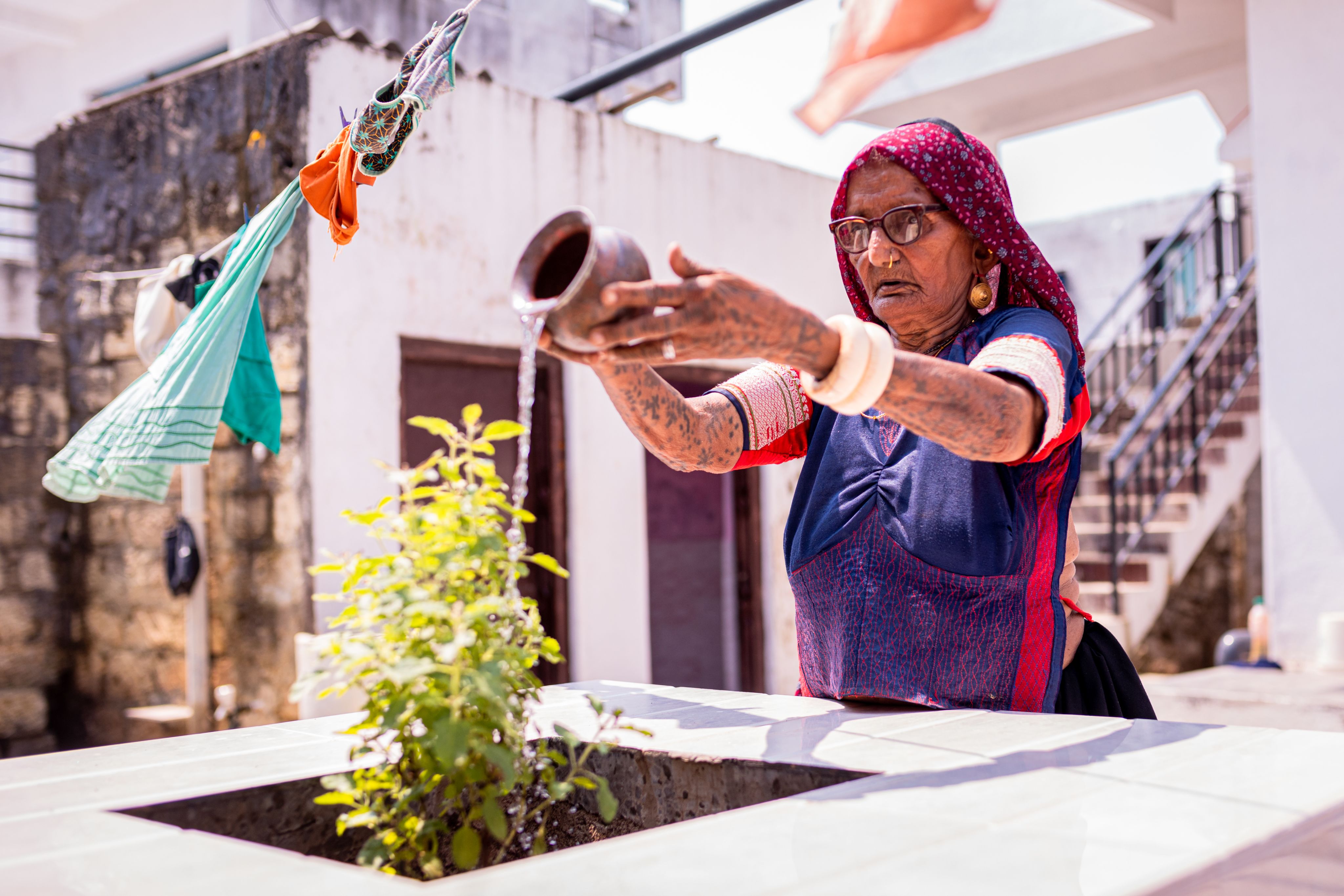
As the effects of climate change worsen, safeguarding and restoring our water and soil resources will be crucial to the future of farming and life on Earth. Both are inextricably linked, with healthy soils better equipped to retain moisture. For that reason, optimising water use and protecting soil health are cornerstones of the Better Cotton Programme. Alongside learning about the principles of IPM, Better Cotton Farmers also adopt principles of regenerative agriculture, modern irrigation techniques and develop context-specific plans for water and soil health that help them create more productive farms, boost their incomes and restore the landscape.
Better Cotton Farmers in India have already made significant strides in reducing water use.
Nitrogen, whilst a major driver of greenhouse gas (GHG) emissions in cotton production when used excessively, is crucial to soil health. Managing its application is essential for sustainable agriculture in order to boost nutrient cycling, plant health and yields, whilst mitigating adverse environmental impacts. Better Cotton is committed to limiting the application of synthetic fertilisers and replacing them with organic alternatives when relevant, appropriate, or where possible.
When we look at nitrogen use over the past eight seasons, we see that after a peak of use in the 2017-18 season, Better Cotton Farmers reduced their synthetic nitrogen application per hectare, saving on cost of production.
In terms of per metric ton of lint, however, due to yield variations there is only a very modest downward trend. The programme will continue supporting farmers to optimise fertiliser use, including synthetic nitrogen, and to strive for better yields.
Sustainable Livelihoods
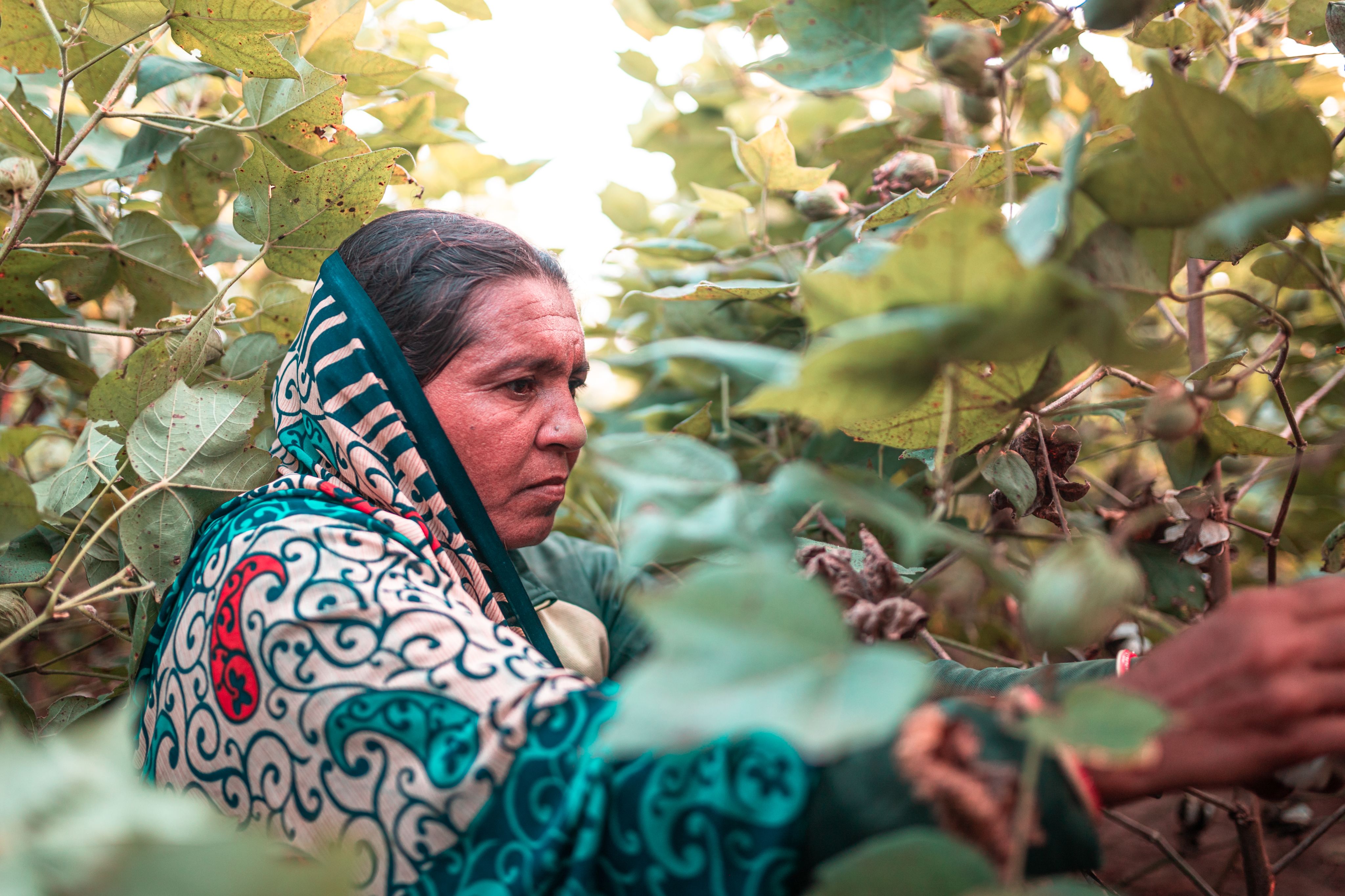
Better Cotton is committed to supporting sustainable livelihoods for India’s cotton communities. That means supporting cotton farmers, farm workers and farming communities to gain access to resources and use the resources available to them to improve their wellbeing and economic situation without harming the environment or others, now and in the future.
Results indicator data between the 2014-15 to 2021-22 cotton seasons show that total production costs per hectare (excluding land renting) decreased by 15.6% in 202122 compared to the three-season average (2014-15, 2015-16 and 2016-17).
This was mainly driven by reductions in labour expenses for land preparation and seed and fertiliser expenses. At the same time, profits per hectare remained stable or even trended slightly higher, with season 2021-22 resulting in particularly outstanding profits due to exceptional international prices.
In the Better Cotton 2030 Strategy, we set an aim of supporting deeper economic and social impact for cotton farming communities around the world and put forward a holistic framework that supports sustainable livelihood improvements. This ‘sustainable livelihoods approach’, launching this year, goes beyond tracking the profitability of the cotton crop (i.e., income from the crop minus variable production costs) – it aims to continuously improve the design and implementation of the Better Cotton Programme over time to make sure that it is delivering effective impact on livelihoods at field-level.

Decent Work
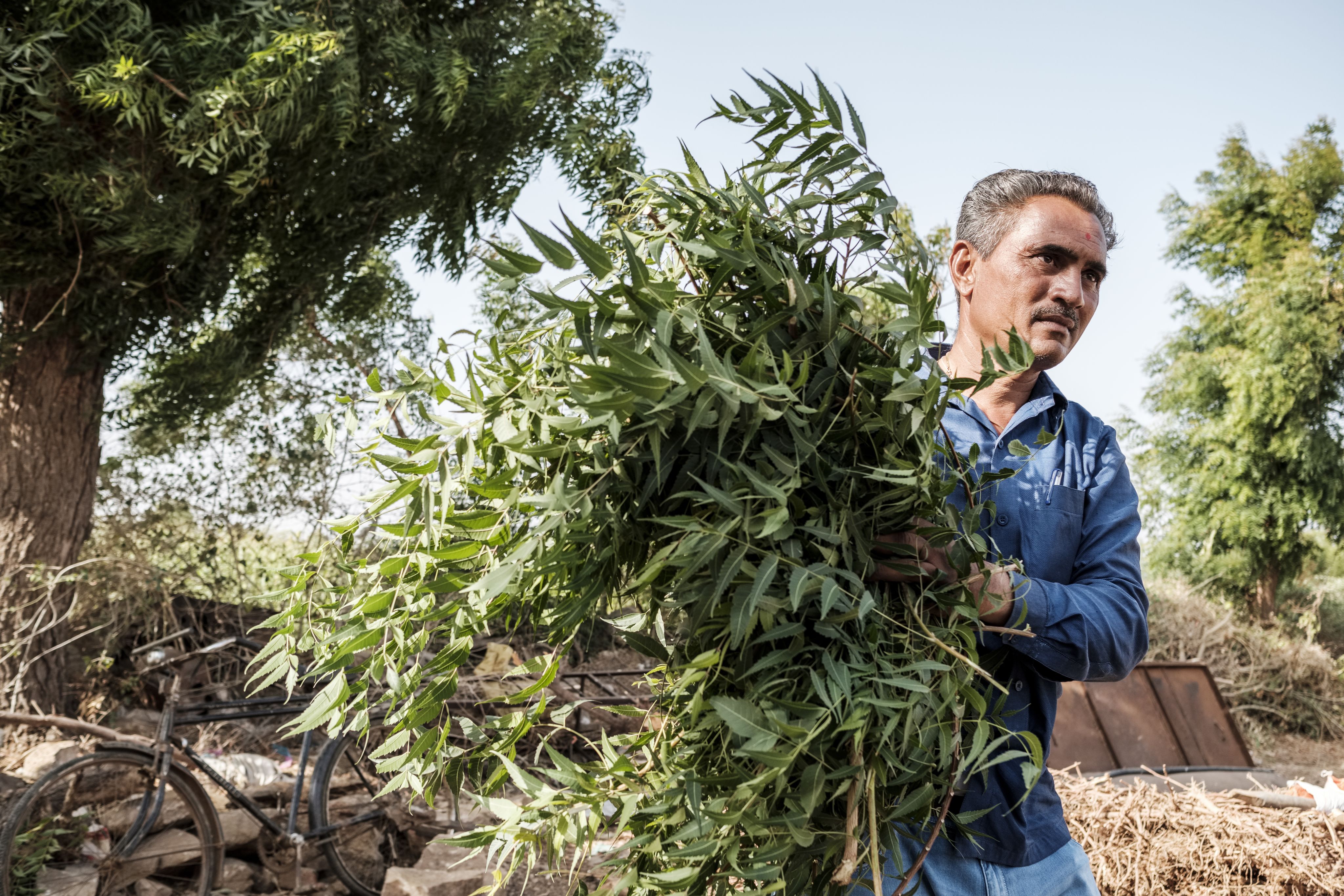
In 2020, Better Cotton formed a task force composed of field experts to advise us on how we could strengthen our standards and programmes related to decent work and forced labour in agriculture. Based on the task force’s recommendations, we formulated and began implementing our Decent Work Strategy. This strategy follows a risk-based, phased approach to addressing the root causes of the multifaceted challenges faced by workers, including poverty, limited awareness of labour rights and lack of access to effective grievance mechanisms. The first step involved a global mapping of forced labour risks, which highlighted the high-risk nature of agricultural work in many countries where Better Cotton operates. As a result of this mapping, India was identified as a priority country.
In response to this, in 2021, we piloted our new strategy with the community organisation Jan Sahas to improve access to social security and support systems for labour rights issues in the Indian states of Madhya Pradesh and Maharashtra. During the 17-month pilot, Jan Sahas promoted a helpline and Migrant Resource Centre to more than 27,000 cotton farmers and workers across six districts and enrolled 21,800 farmers and workers in government social security schemes.
In 2022, we also collaborated with the Centre for Child and the Law of the National Law School of India University Bangalore to gain a comprehensive understanding of the distinction between child labour and age-appropriate work in the specific national context of India. Building upon this research, we developed practical guidance documents that aim to assist Better Cotton Staff and Programme Partners, as well as the verifiers we collaborate with, in understanding child labour risks and mitigation measures.

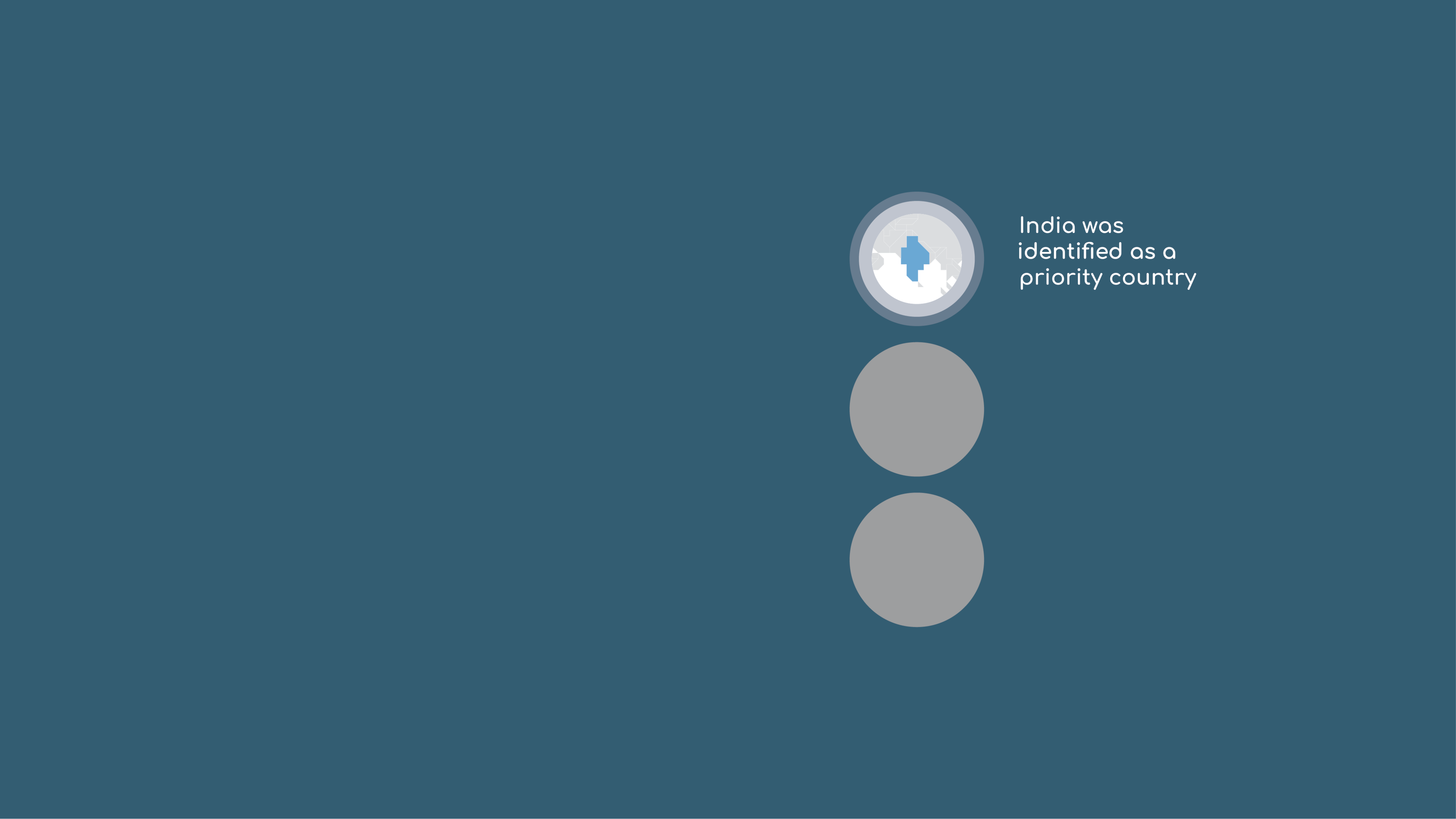


In 2020, Better Cotton formed a task force composed of field experts to advise us on how we could strengthen our standards and programmes related to decent work and forced labour in agriculture. Based on the task force’s recommendations, we formulated and began implementing our Decent Work Strategy. This strategy follows a risk-based, phased approach to addressing the root causes of the multifaceted challenges faced by workers, including poverty, limited awareness of labour rights and lack of access to effective grievance mechanisms. The first step involved a global mapping of forced labour risks, which highlighted the high-risk nature of agricultural work in many countries where Better Cotton operates. As a result of this mapping, India was identified as a priority country.
In response to this, in 2021, we piloted our new strategy with the community organisation Jan Sahas to improve access to social security and support systems for labour rights issues in the Indian states of Madhya Pradesh and Maharashtra. During the 17-month pilot, Jan Sahas promoted a helpline and Migrant Resource Centre to more than 27,000 cotton farmers and workers across six districts and enrolled 21,800 farmers and workers in government social security schemes.
In 2022, we also collaborated with the Centre for Child and the Law of the National Law School of India University Bangalore to gain a comprehensive understanding of the distinction between child labour and age-appropriate work in the specific national context of India. Building upon this research, we developed practical guidance documents that aim to assist Better Cotton Staff and Programme Partners, as well as the verifiers we collaborate with, in understanding child labour risks and mitigation measures.
Women in Cotton
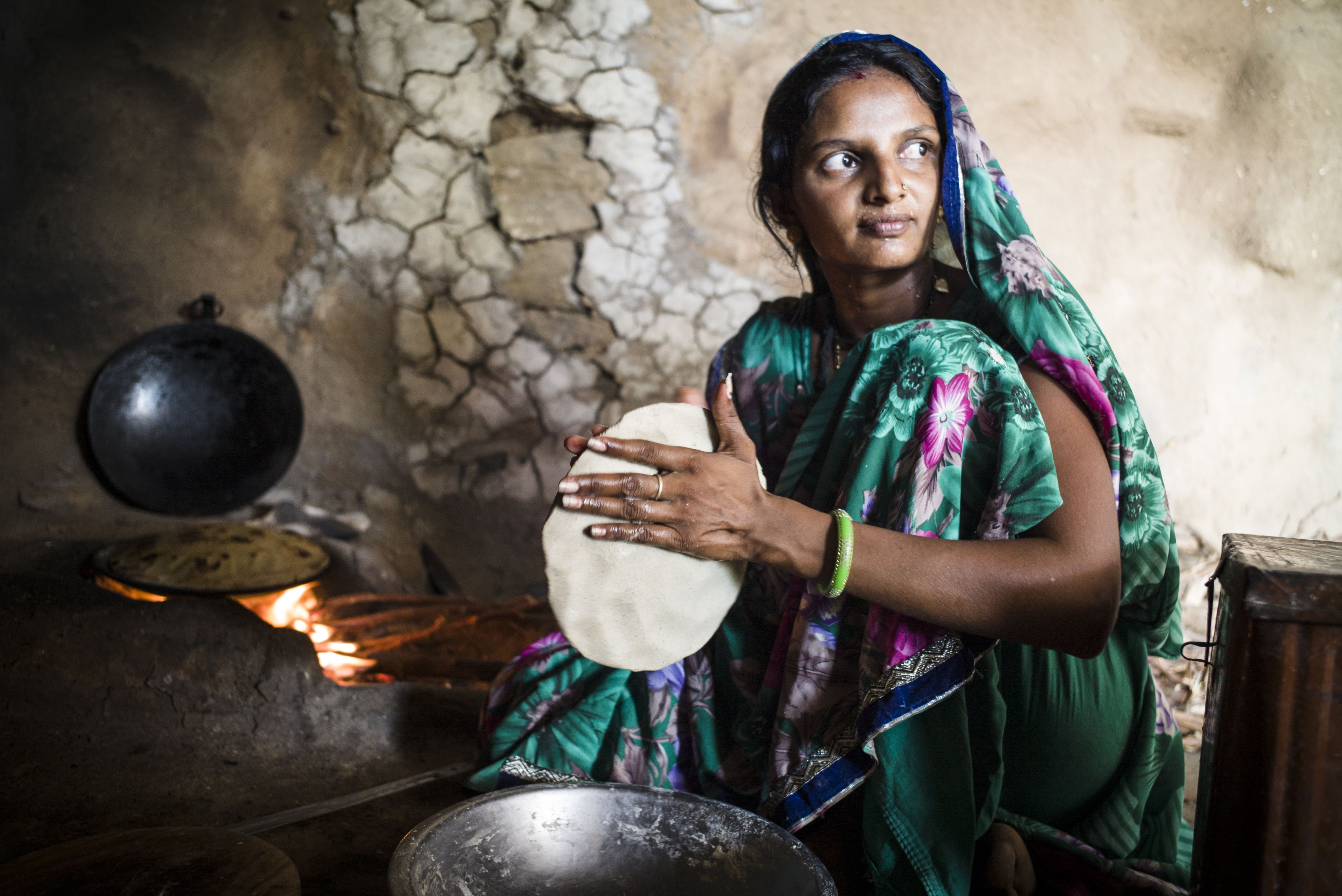
Women make up the majority of the cotton farming workforce in India. While they take on important and demanding roles, their contribution is often overlooked and undervalued. At Better Cotton, we know that women are essential to creating a more sustainable future, which is why gender equality is a key aspect of the Better Cotton Programme. Our Gender Strategy outlines our plans to systematically mainstream gender concerns, needs and interests across our policies, partnerships and programmes.
As we steadily ramp up our efforts to increase the inclusion of women in cotton farming communities in India and beyond, we are already seeing some early results. There has been an overall increase in the number of women Better Cotton Field Staff across India. In the 2019-20 cotton season, around 10% of Field Facilitators were women, rising to over 25% in the 2022-23 cotton season. Additionally, selected Better Cotton Programme Partners in India now run Producer Units with only women farmers and an average of 70% women staff members.
At Better Cotton, we recognise that gender equality is an ongoing journey. As we work to increase inclusion and awareness throughout the cotton sector, we are seeking partnerships and opportunities that bring us closer to our vision of an equitable cotton sector for all.
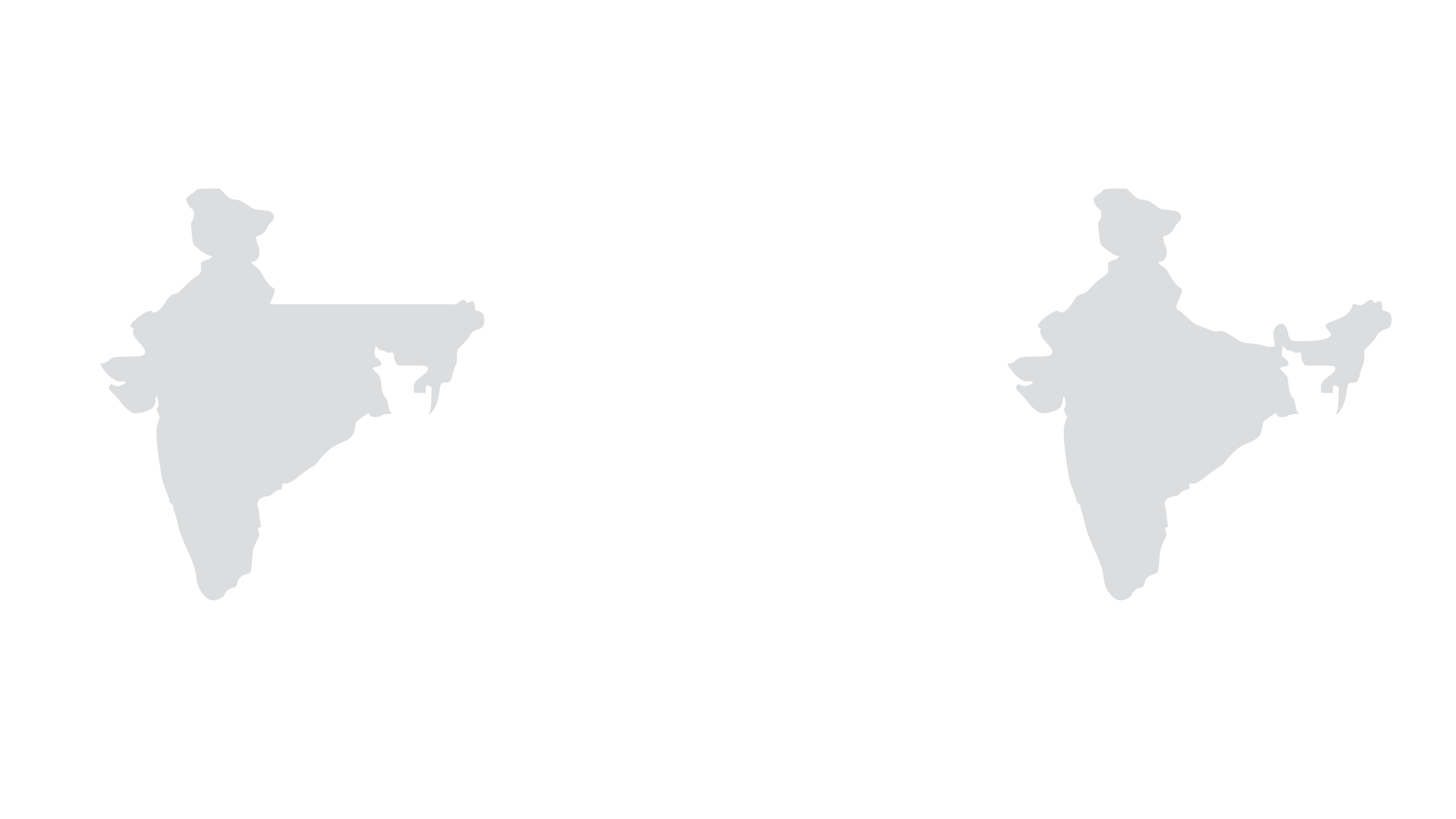
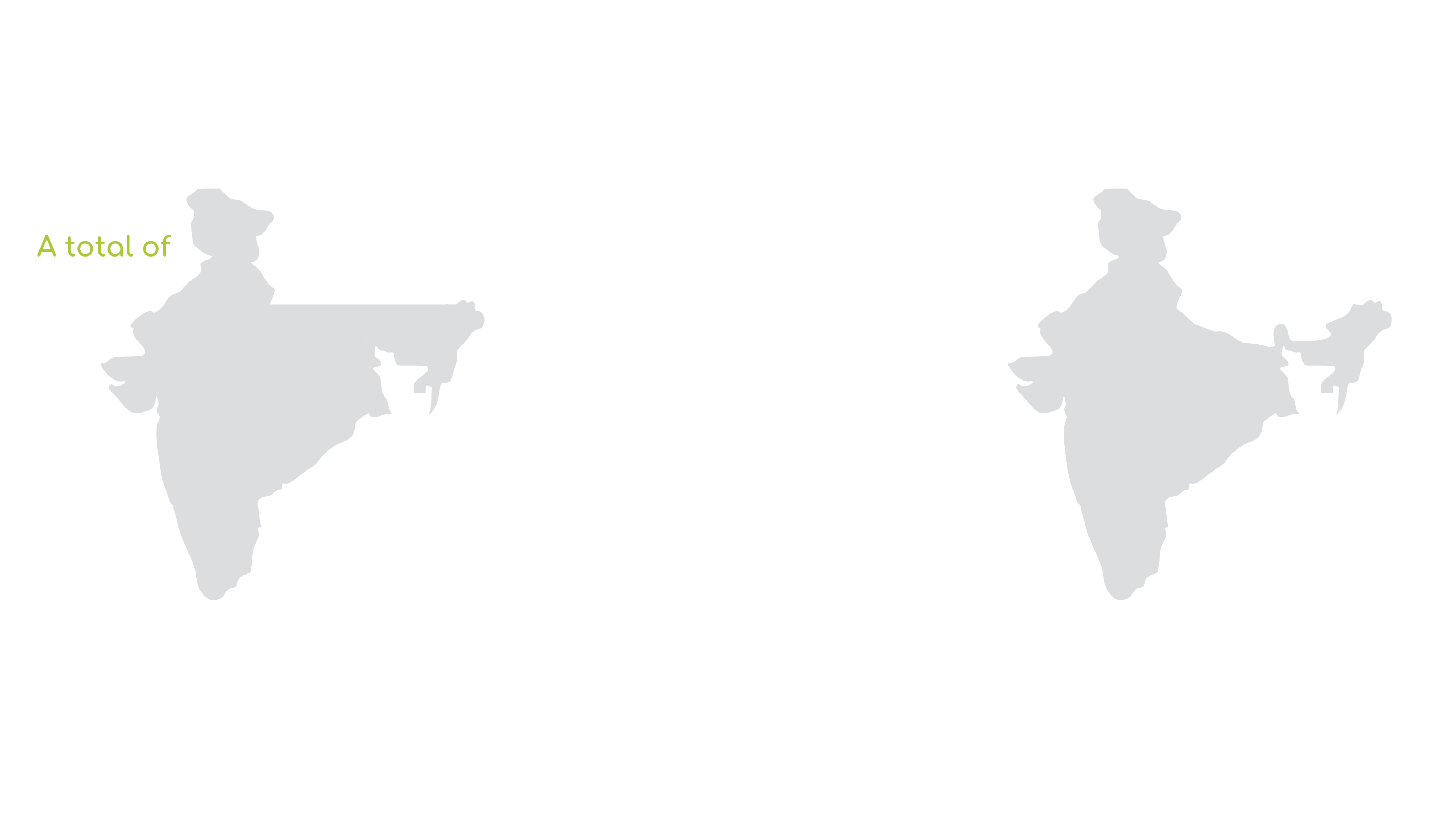
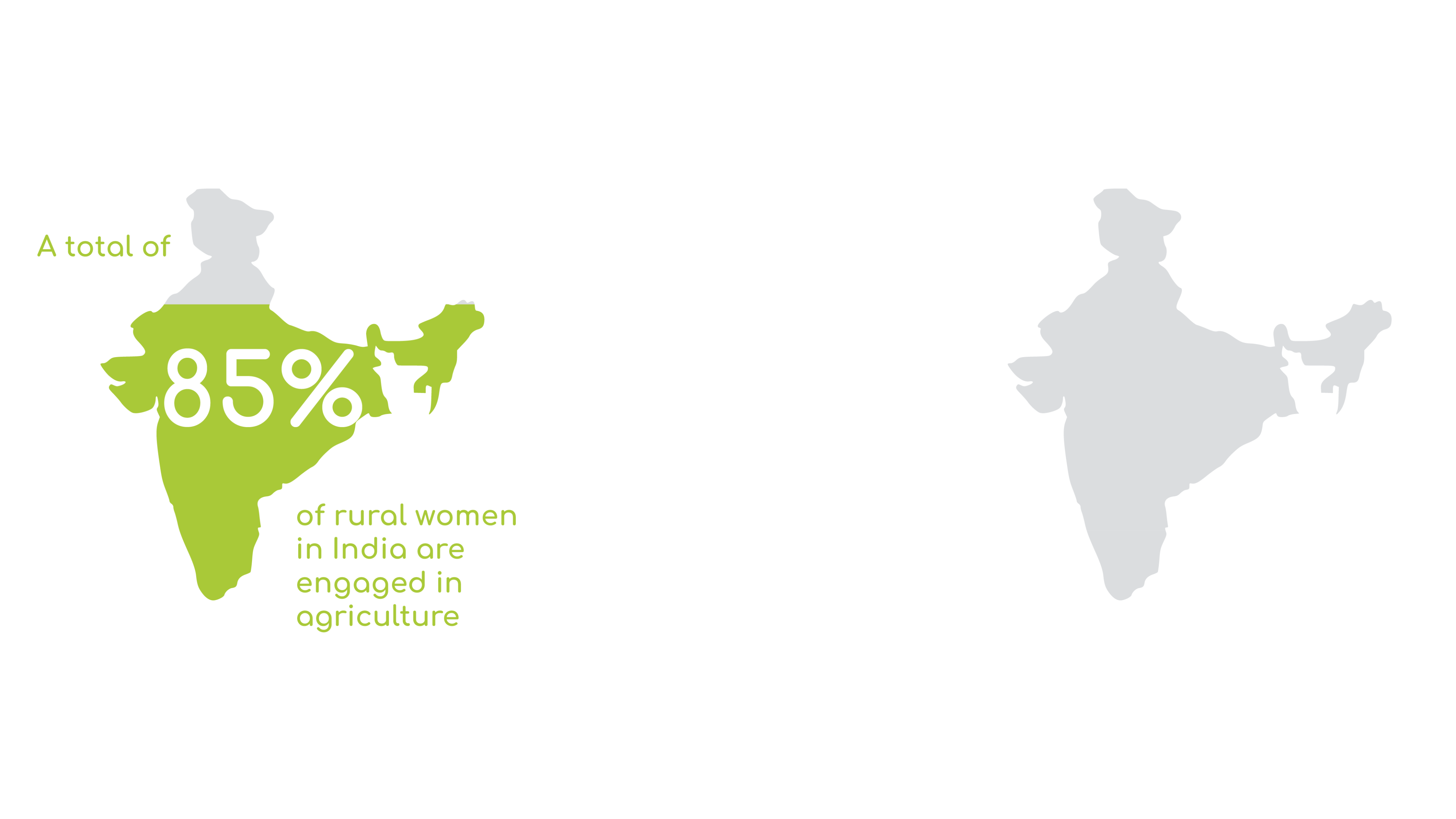
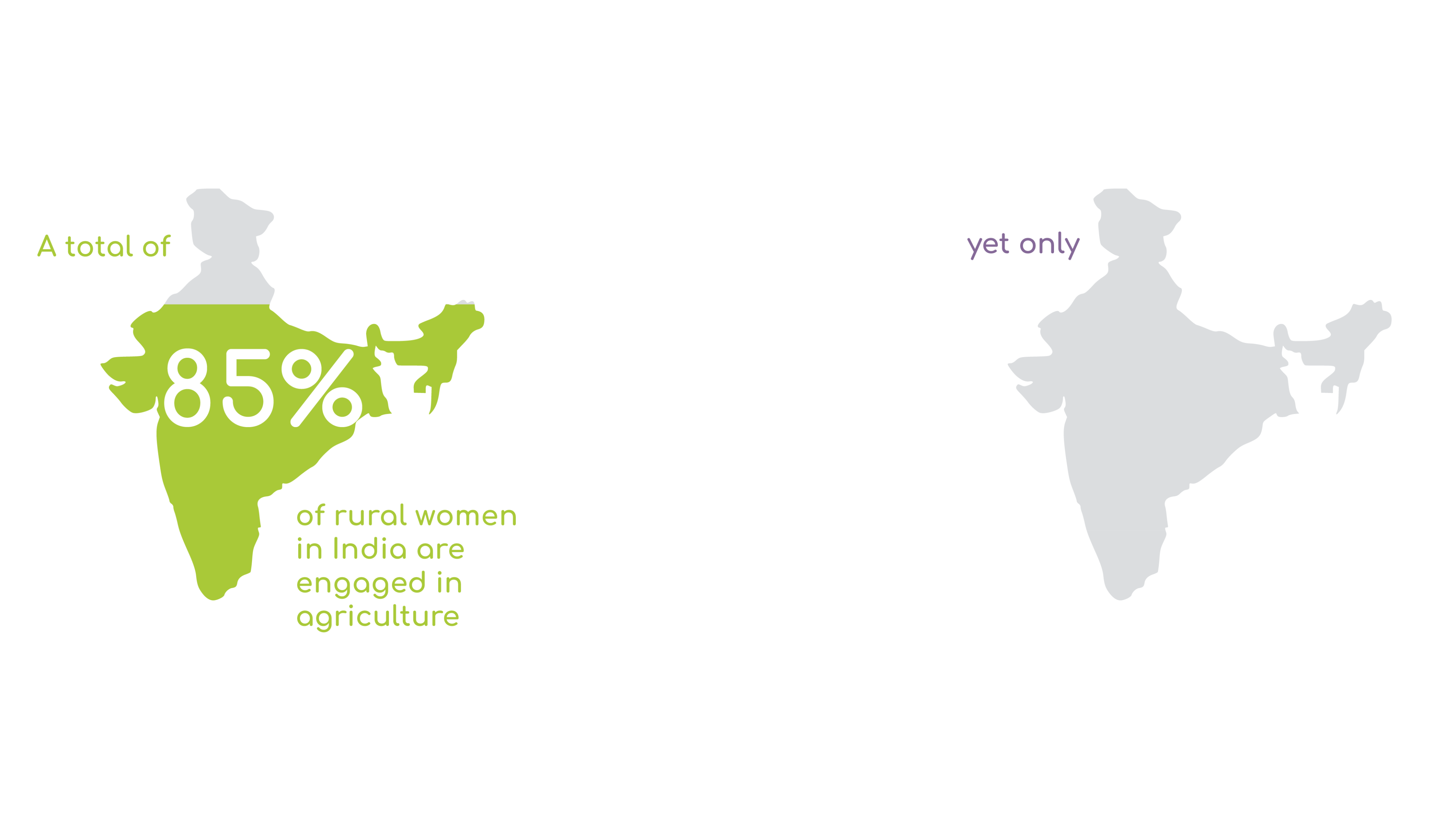
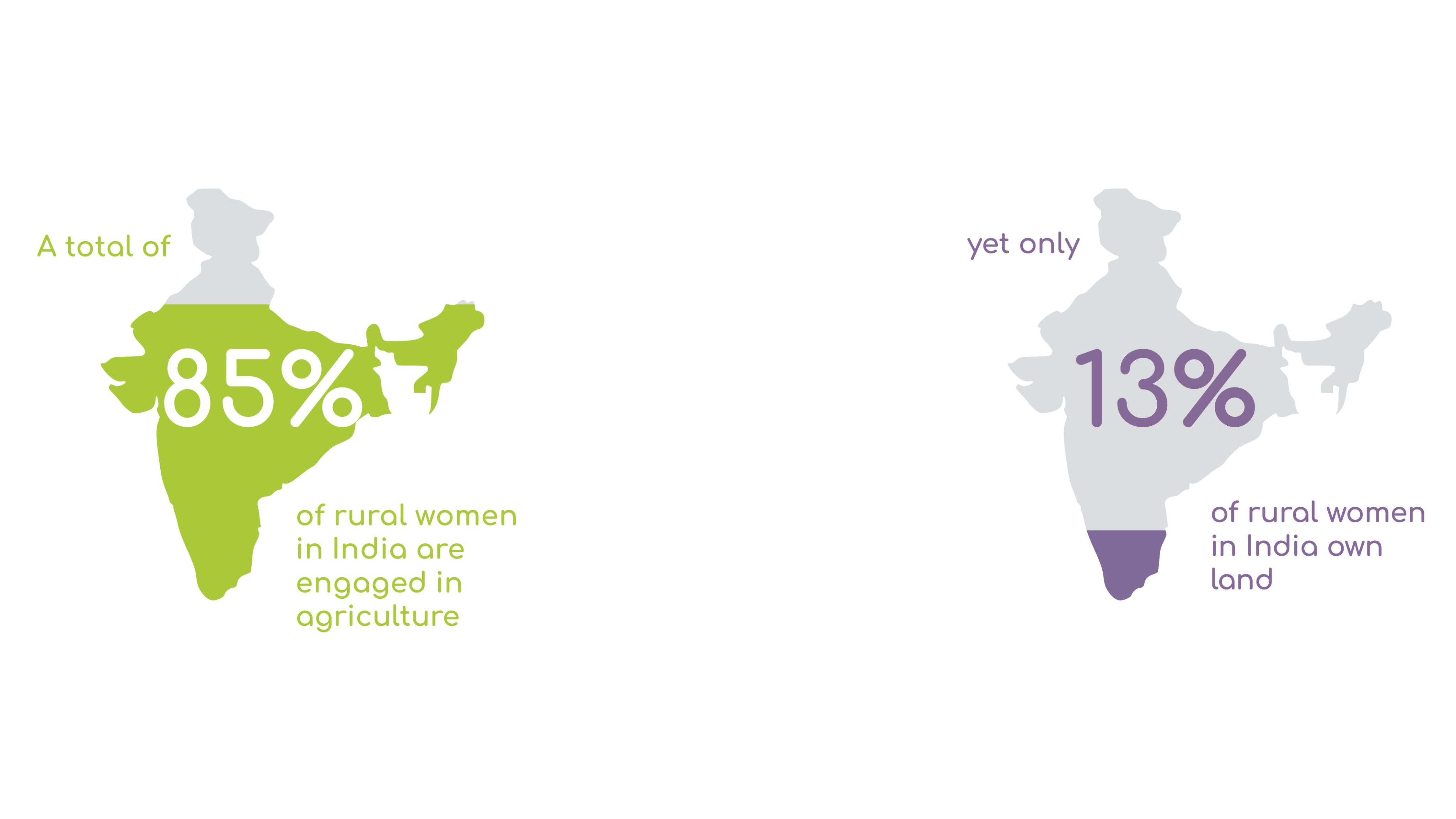
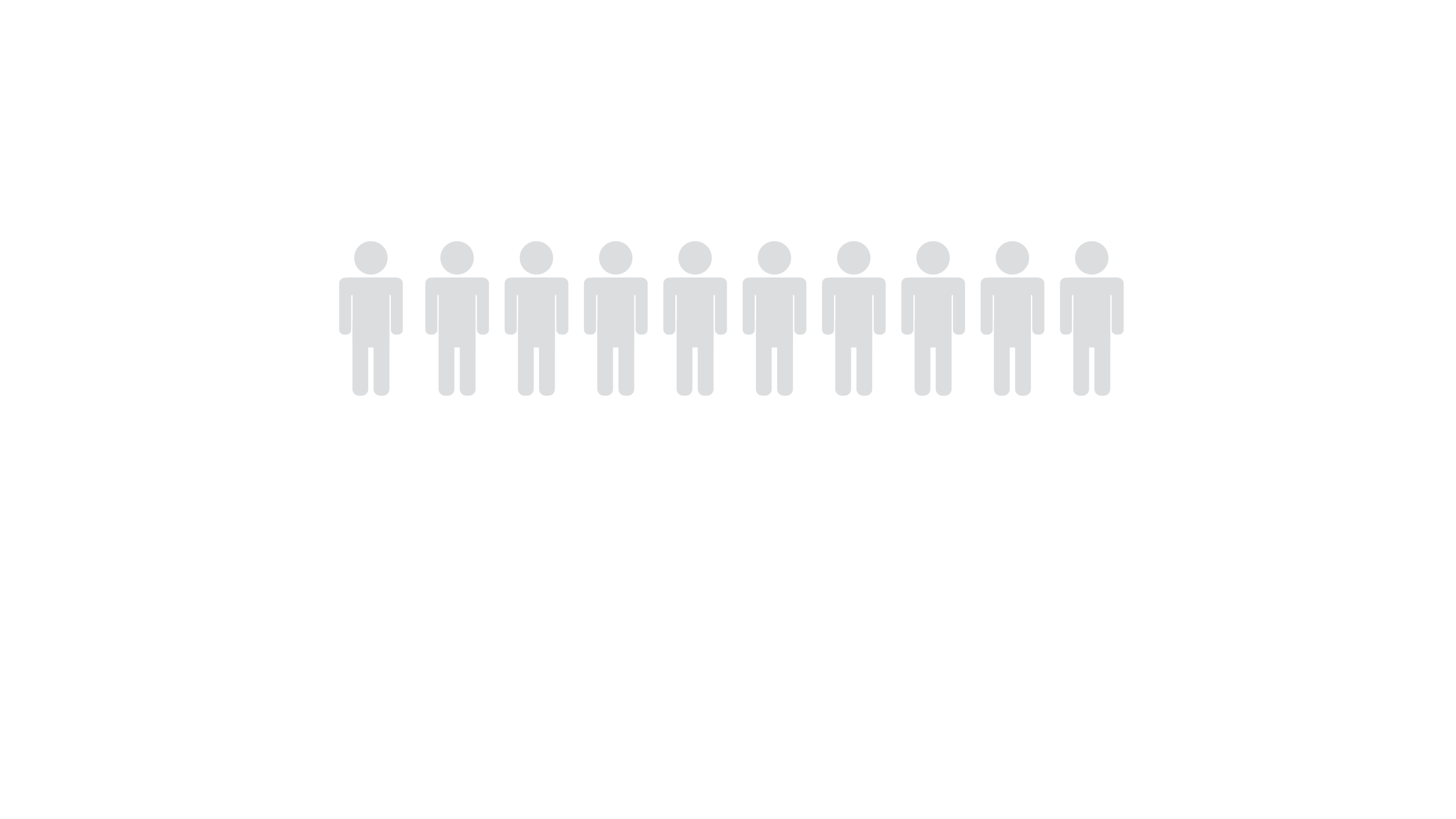
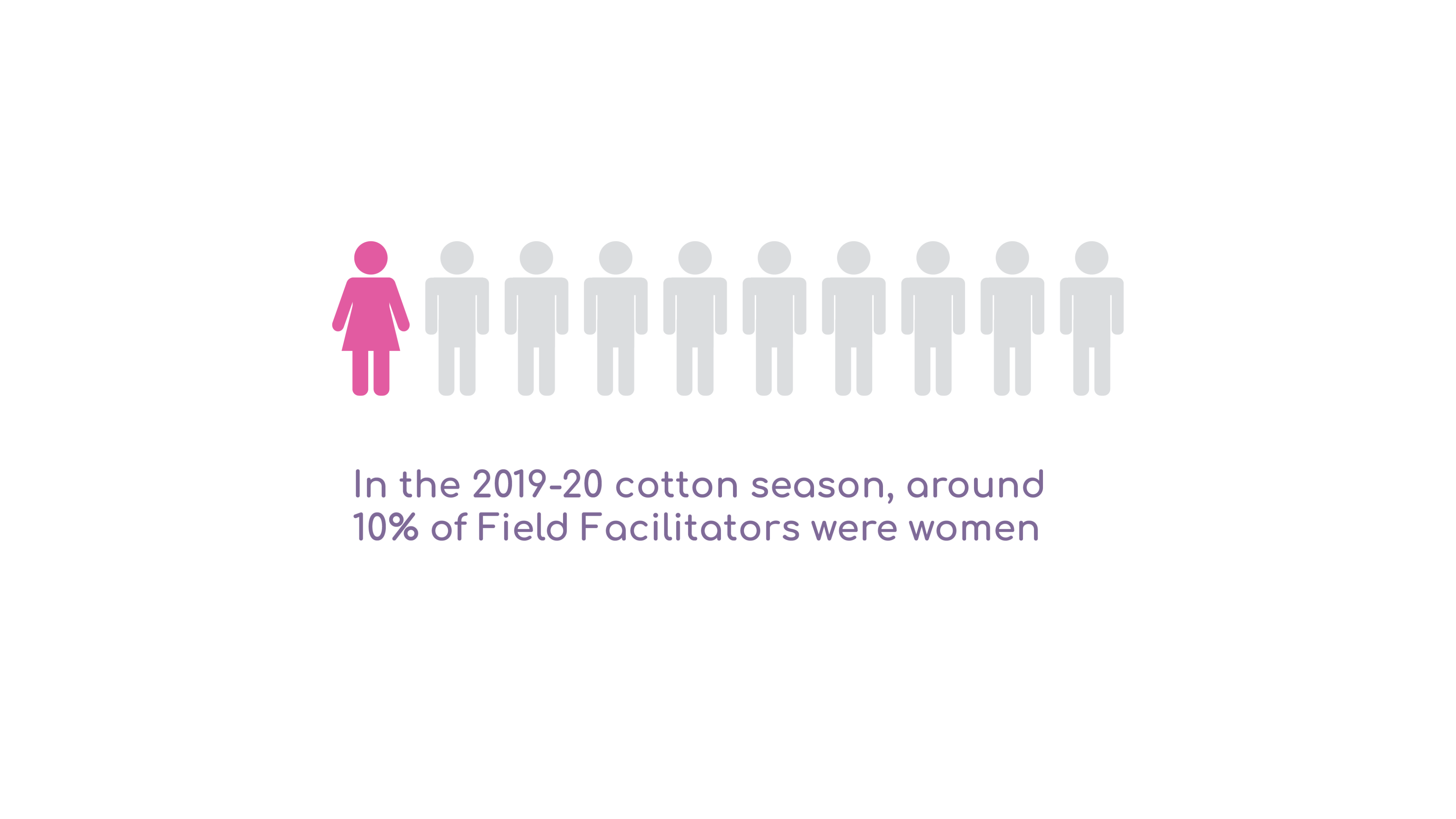
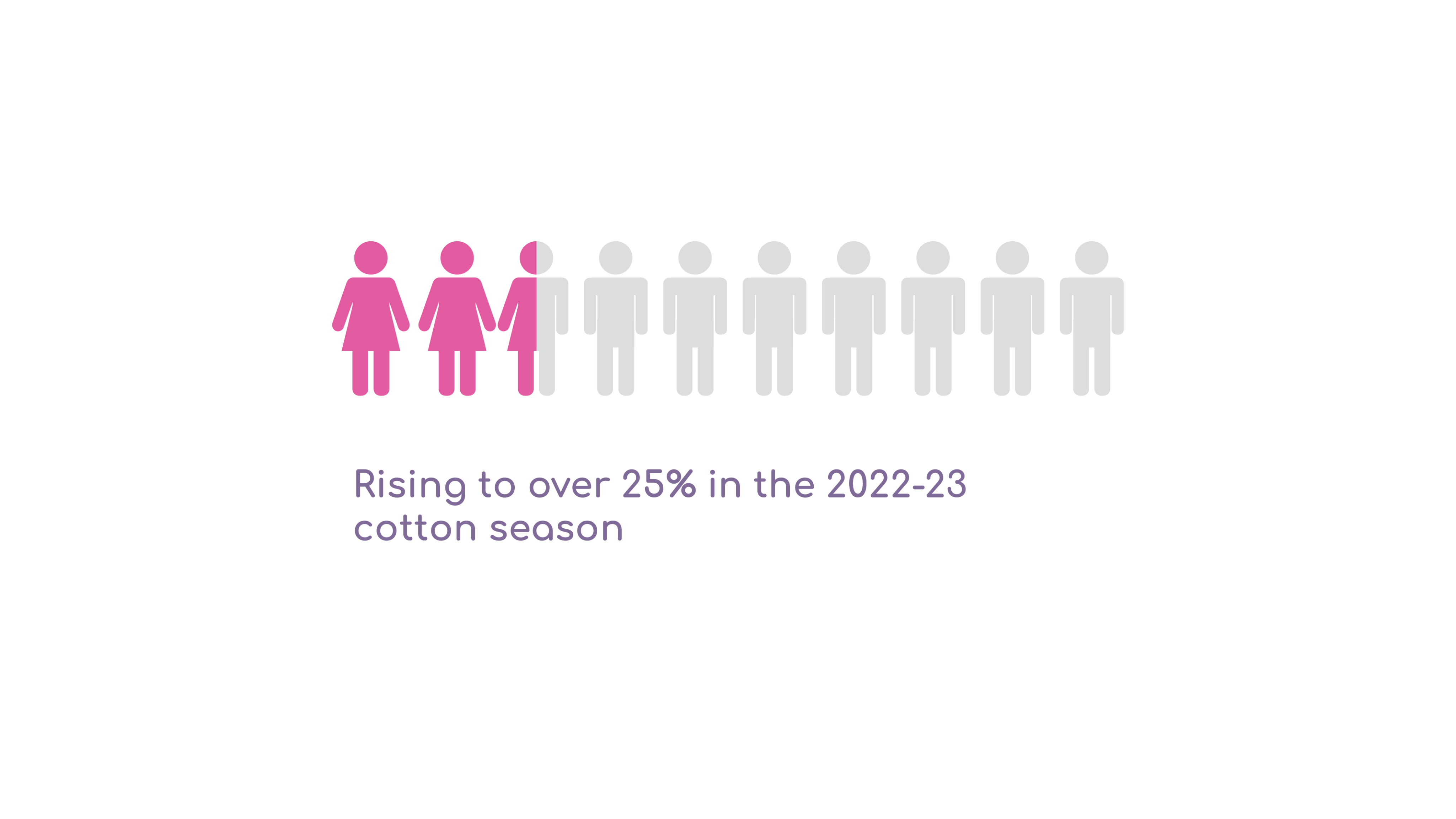
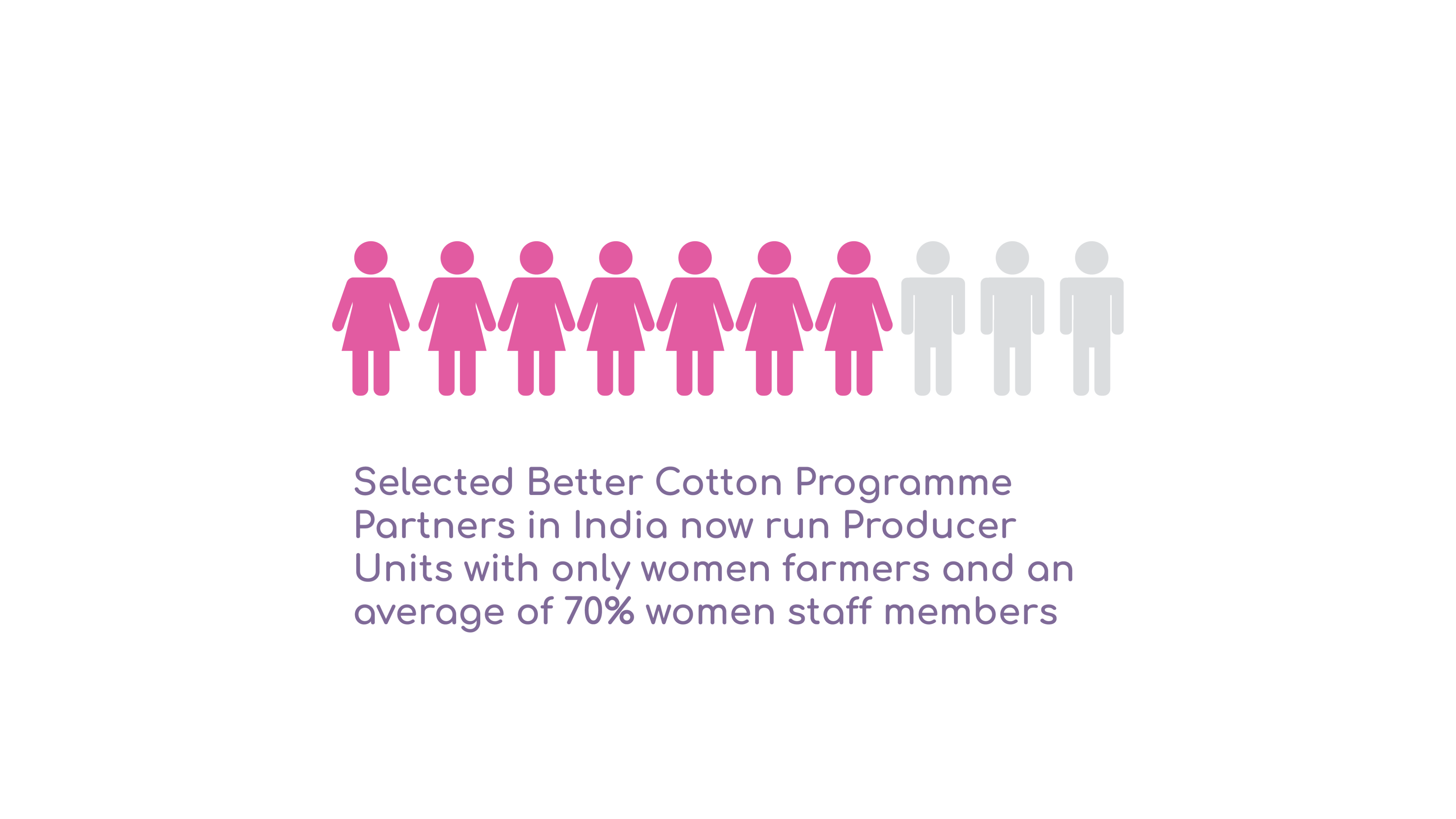
Women make up the majority of the cotton farming workforce in India. While they take on important and demanding roles, their contribution is often overlooked and undervalued. At Better Cotton, we know that women are essential to creating a more sustainable future, which is why gender equality is a key aspect of the Better Cotton Programme. Our Gender Strategy outlines our plans to systematically mainstream gender concerns, needs and interests across our policies, partnerships and programmes.
As we steadily ramp up our efforts to increase the inclusion of women in cotton farming communities in India and beyond, we are already seeing some early results. There has been an overall increase in the number of women Better Cotton Field Staff across India. In the 2019-20 cotton season, around 10% of Field Facilitators were women, rising to over 25% in the 2022-23 cotton season. Additionally, selected Better Cotton Programme Partners in India now run Producer Units with only women farmers and an average of 70% women staff members.
At Better Cotton, we recognise that gender equality is an ongoing journey. As we work to increase inclusion and awareness throughout the cotton sector, we are seeking partnerships and opportunities that bring us closer to our vision of an equitable cotton sector for all.
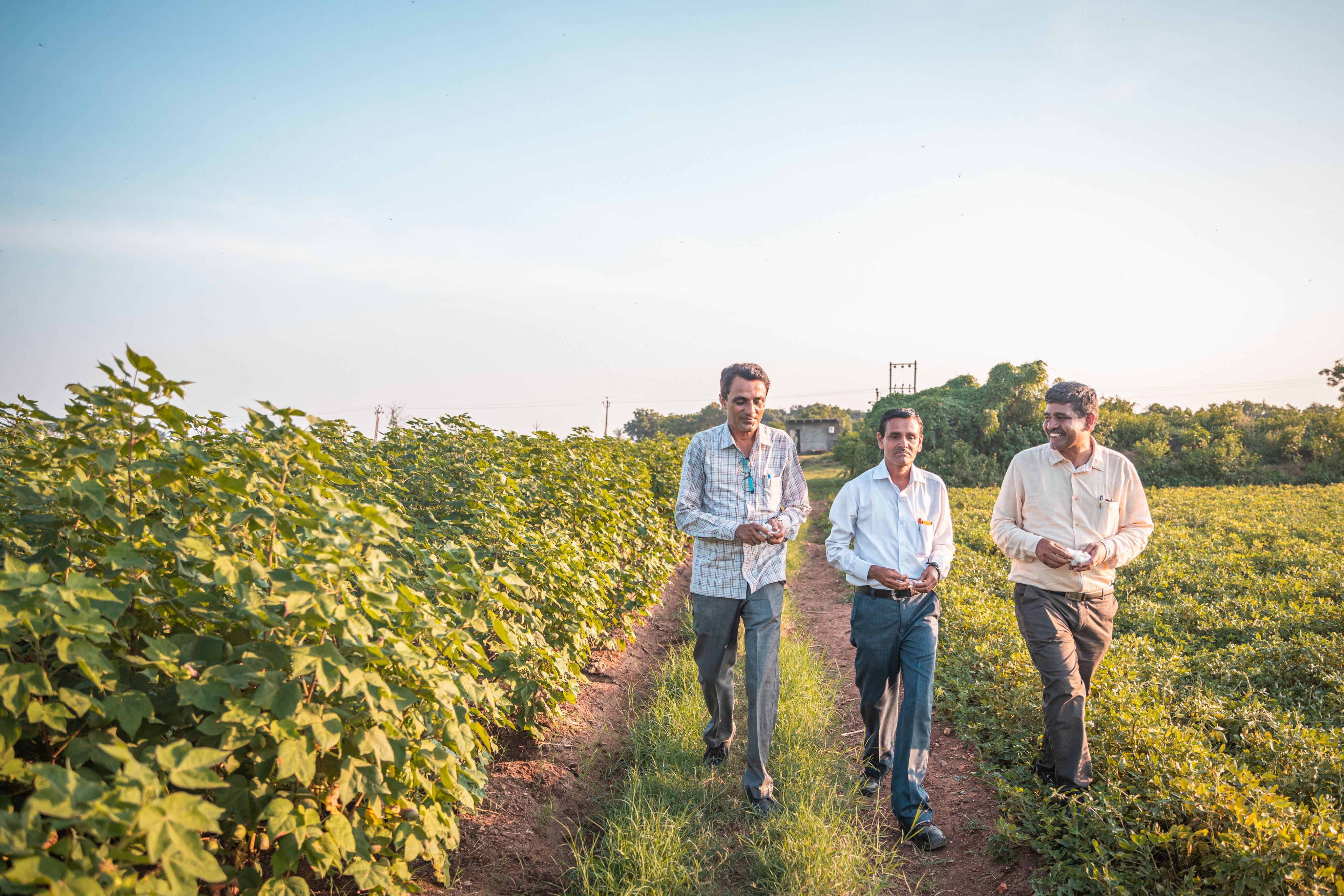
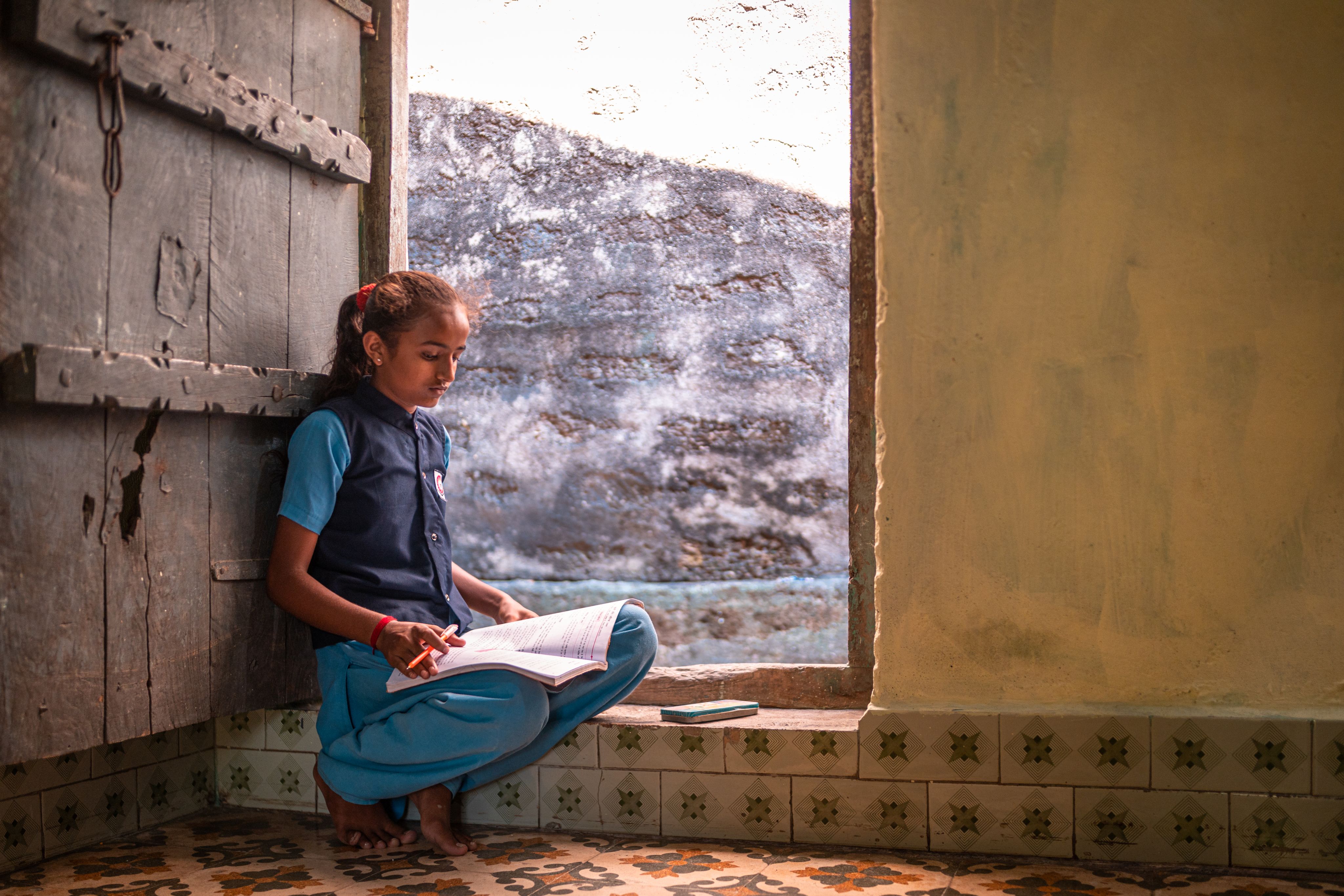
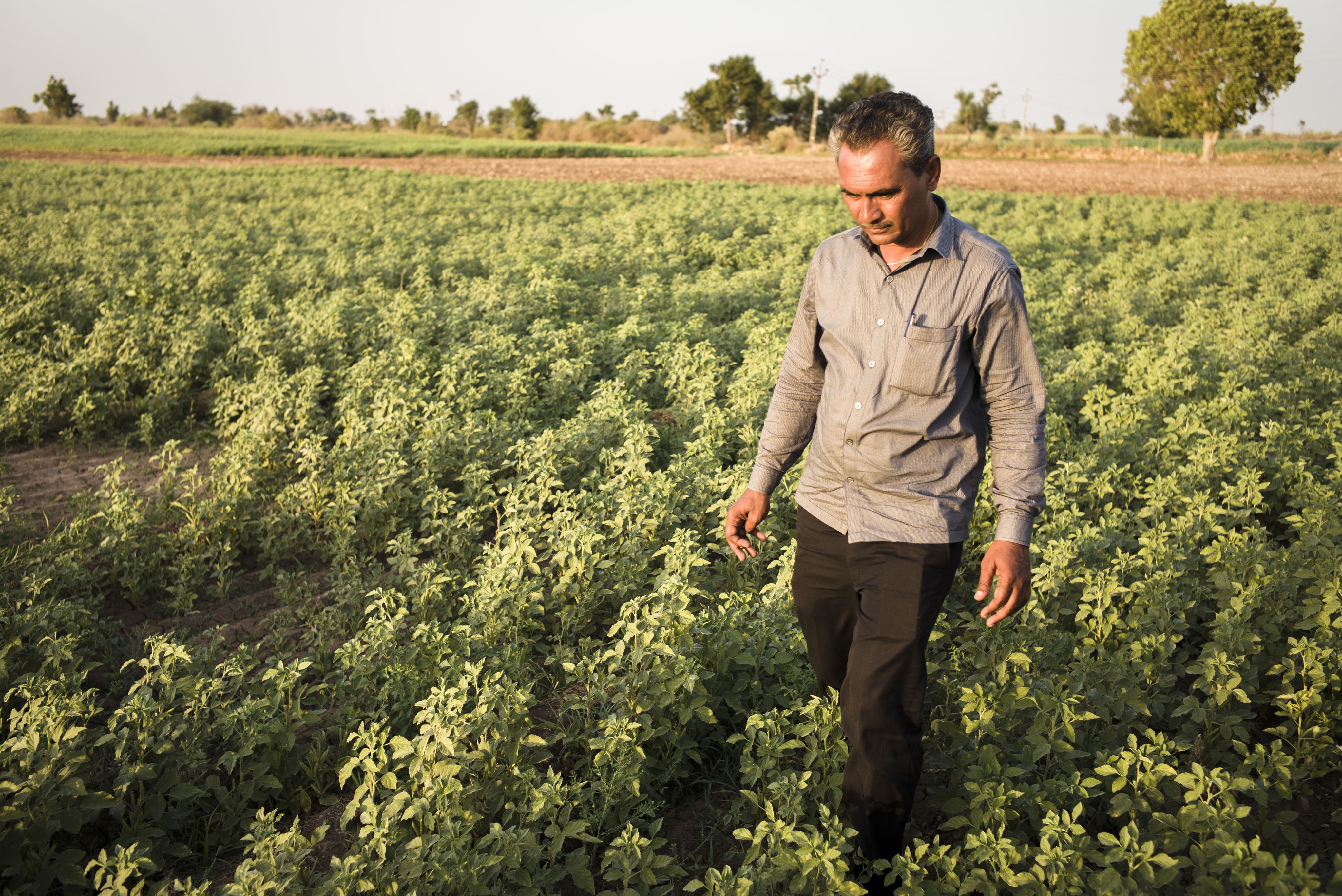
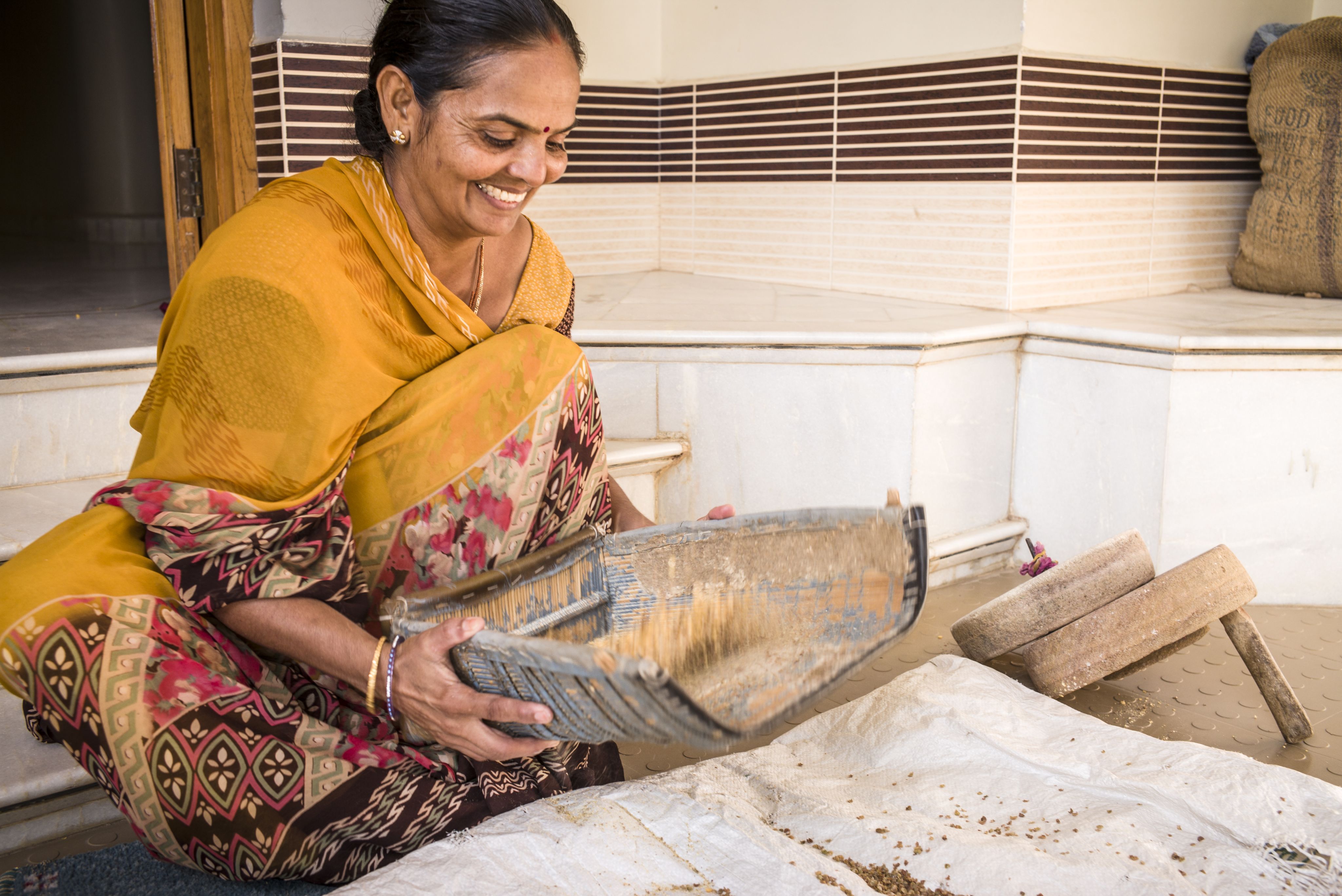
Conclusion
The Better Cotton Programme in India has come far since its inception in 2011. With nearly one million farmers and counting, our goal for this next phase, in line with our 2030 Strategy, is on deepening impact.
As we work to do so, these results provide us with key insights that are helping us align our stakeholders and prioritise our areas of focus.
Though challenges remain, notable results for yields; reductions in pesticide use; advancements in water and soil health; and progress towards sustainable livelihoods and gender equality in the cotton farming communities where Better Cotton is active, show us that we are on the right track to a more equitable and sustainable future for the sector.
Future Focus
Better Cotton is committed to providing higher levels of investment in strengthening programme delivery in India – and globally – to speed up progress.
On top of all the work we’re already doing with our partners, some of the ways that we’re looking to make this possible are through:
- Building stronger, more effective and inclusive partnerships with existing and potential partners in the country, including Programme Partners, agricultural research centres (KVKs), individual agricultural experts, and civil society organisations (CSOs) .
- Building increased adaptive capacities to climate vulnerability among farmers and communities, such as through mapping farmer practices, developing and implementing pilot carbon projects; identify and implementing opportunities for Payment for Ecosystem Services for farmers.
- Further development of social impact capacity in India, via collaboration with current and new civil society partners on labour rights, decent work and sustainable livelihoods projects, as well as developing and implementing pilots. This will also encompass identifying and implementing opportunities to directly engage workers in Occupational Safety and Health Trainings
Traceability
As part of our 2030 Strategy, Better Cotton is implementing a traceability solution at the end of 2023 to ensure that Better Cotton Farmers can continue to access increasingly regulated international markets. Traceability has the potential to create huge value for Retailer and Brand Members of Better Cotton and those they source from – but we need to ensure that it also creates value for growers at the start of the chain – including the smallholders that make up the majority of cotton farmers in places like India.
Towards an Impact Marketplace
Better Cotton is also committed to developing an Impact Marketplace, built on the foundations of our field-level presence, capacity strengthening, monitoring approach and upcoming physical traceability system.
The marketplace aims to:
- Improve farmer livelihoods: through a combination of incentive payments and remuneration for sustainable outcomes and metrics.
- Accelerate sustainability progress: leading to deeper impacts in areas such as regenerative agriculture, water reductions, and gender equality .
- Create new sources of verified outcome data for those that source Better Cotton: enabling credible claims that align with organisational sustainability priorities and reporting requirements .

